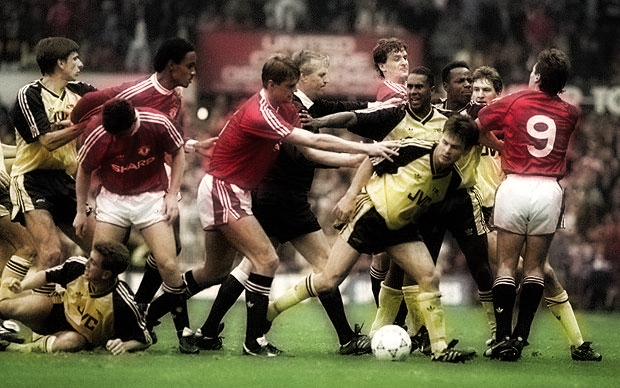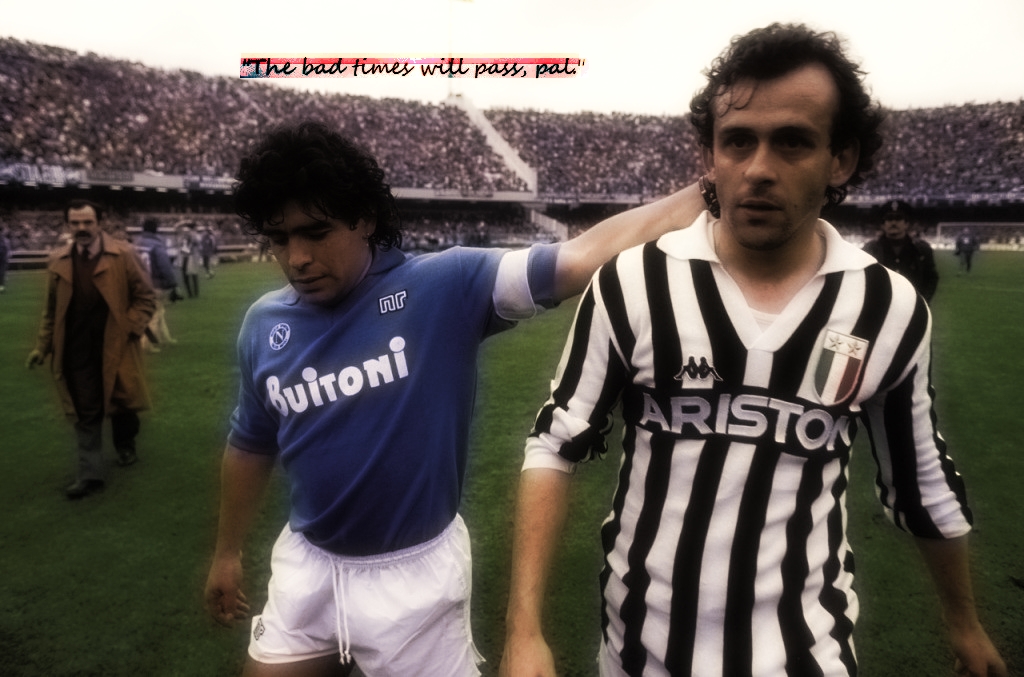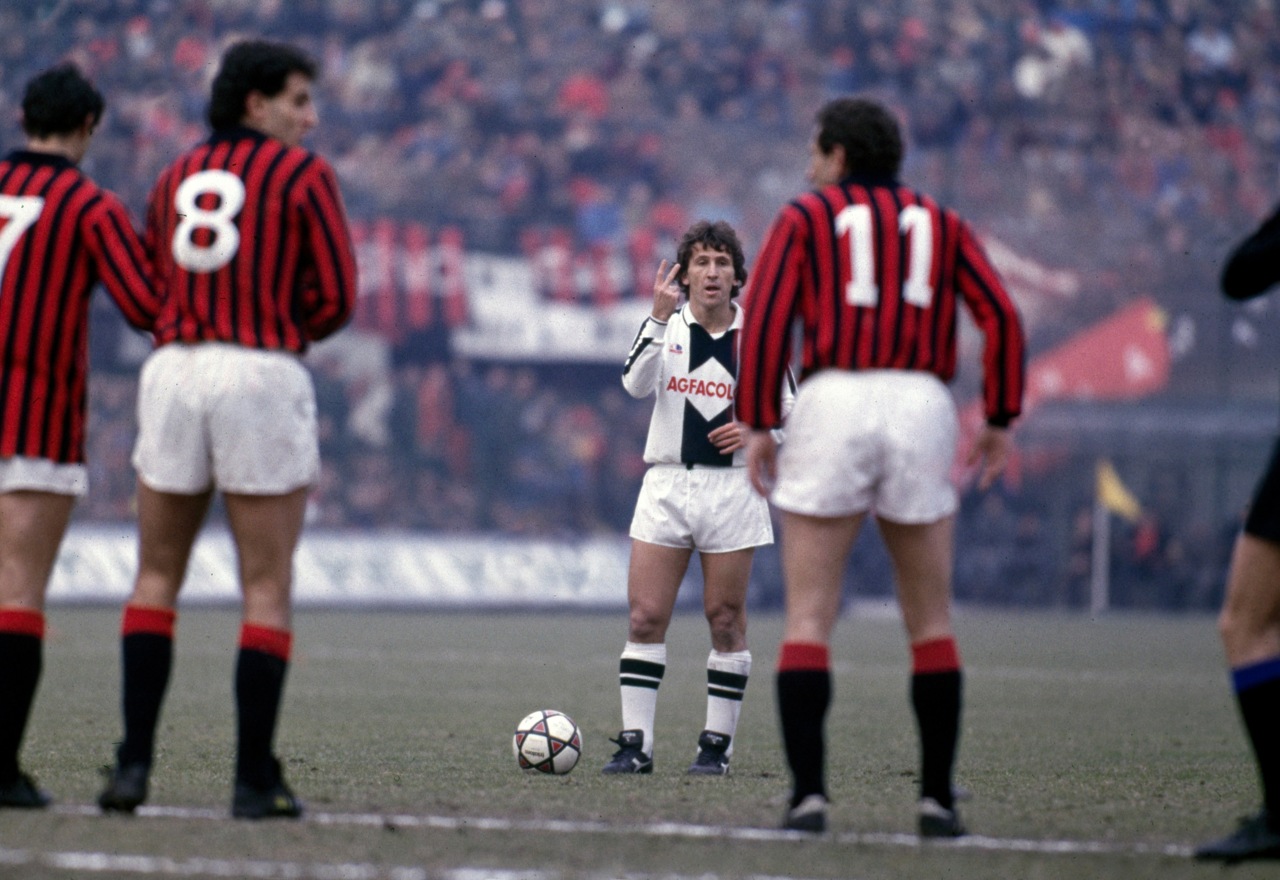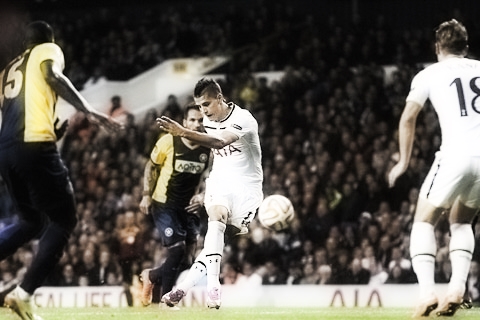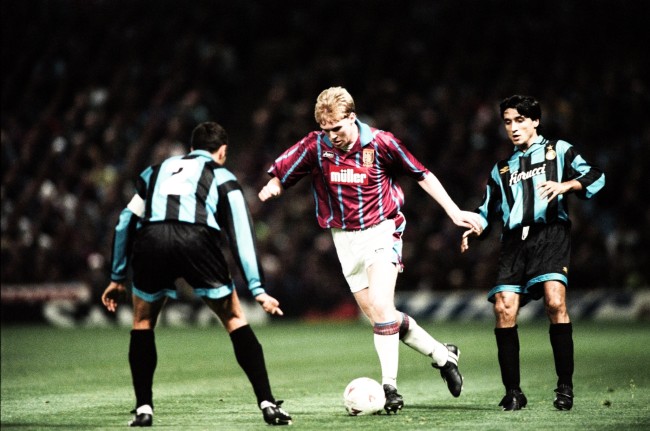 So, the end of the road came for Mourinho. Mutually frogmarched out of the club having presided over a dip in performance deeper than the journey taken by Villas Boas and without precedence in his own career. Nobody is denying that the human factors behind this drop in performance have precluded his retention but beyond that it seems wrong to presume that in turning his Champions into Chumpions, he had much leeway to continue. The demands of helming a mega-club require only the finest returns and presumably only his reputation, or financial considerations, kept him alive for this long. It has been noted that his team have improved in recent weeks, but that improvement has come from a very low base. Dotted among the poor results have been occasional solid performances that have lacked the finishing touches. The team still controlled possession in the majority of it's games, at least when not facing teams that pressed, and just couldn't find some finishing smarts. The recent withdrawal of Costa from a starting role compounded that issue. As so often, when faced with a challenge, Jose reverted to a defensive set-up, never more comprehensively than in the attacking void that was the Tottenham away fixture. In rolling over Sunderland and going back to the future again with Hiddink, it looks like all could be right in their world once more, but getting two nil up inside thirteen minutes against a struggling team is a perfect scenario in any game and reminiscent of the marvellous run that laid their title foundations at the start of last season. Where they end up from here is hard to predict for the weight of the apparent Mourinho anchor is hard to measure. Top four vanished from view some weeks back, the Europa League undesirable and it looks like the whole season rests on an ability to outfox PSG. There are still question marks over how many of the team in key defensive roles are yesterday's men: Terry? Ivanovic? Fabregas even? And the form of Matic, Costa and Hazard, so pivotal last year, needs to revert quickly, for when a squad appears in flux a strong base of performance is needed to redefine a preferred starting eleven. Anyway... Feeling sorry for Villa That Aston Villa aren't very good and haven't been very good isn't really in dispute. Having attempted to blend smart recruitment with old school management Sherwood-style and unsurprisingly failed to find a common ground, the hiring of Remi Garde at least looks like a case of theory starting to match reality. The main problem they face is that they have seven points from 17 games which is historically terrible and nearly consigns them to the Championship before even the year's end. What's unfortunate is that while bad, they haven't been necessarily worse than any of the other bad teams. Newcastle and Sunderland have failed to impress in many matches, Norwich have been subtly not good without drawing much attention to it and Tony Pulis' army of aging centre backs are doing their usual trick of projecting to be terrible but exceeding the sum of their parts. If I chuck some metrics into a pot, I get Villa as the 17th best team in the league, Paul Riley's xG model has them at 19th and Michael Caley's 18th; all thereabouts among the dross but not worst. Where the pity arrives is that all those teams around them have an advantage of five, seven, ten points or more, which in relegation terms is enormous. In fact no team is undershooting an expected points total by more than Villa; they're somewhere between five and seven points behind a reasonable assumption. All this conspires to leave them in an unenviable position as a club that has tried to adopt a forward thinking strategy to recruitment but has probably run out of time to successfully realise the benefits while retaining their league slot. It's tempting to presume the real issues date back years; the last competitive Villa teams were early in the decade and the personnel from those teams were moved on at great pace. Between 2010-11, their last decent season, and two years later, they retained a historically low volume of first team players. The team was entirely rebuilt (Agbonlahor apart!) and has drifted around the lower reaches of the table ever since: 16th, 15th, 15th and 17th, at no point offering anything like positive shot numbers. That initial quality never got replaced and mediocrity in performance has become standard. Therein lies the problem, when performance levels stagnate – and four and a half seasons of under twelve shots per game reflects that – there is little room for a negative skew or a drop, it will dump you in the bottom three. So while their shot on target rate has floated around the 43-44% mark throughout that time, that it's dived to 37% this year has compounded the problem. It's a shame: despite the obvious issues around ownership, in regard the working operations, they have attempted to move with the times and make progressive decisions at the exact point that their performance levels have dipped and variance has bitten hard. A broader issue is that for analytics to gain ground and penetrate across the board, there is a need for success stories; see Arsene Wenger's horrifically titled but vibrant and insightful discussion just this week. If as seems likely Villa fail to rescue themselves, it's possible that their methods will be derided by the skeptical end of football and the media, when in fact it's likely that they will be well set for the future. It just won't be the immediate future that they had hoped for. A little Leicester riff Continuing to make a mockery of any predictions that they will ultimately fall back (they will) Leicester now sit handsomely on top of the league. The start of their difficult schedule hasn't slowed them up at all as Chelsea in lurching crisis mode couldn't peg them back and Everton's ever generous defence waved in three goals. They still remain an enigma in many aspects, their shot numbers are fine for a team challenging for a Europa place, but there is just no recent precedent for a team that has so little of the ball, or that retains the ball so irregularly to challenge even for the top four. Why it seems so likely that they will fall back is that some of their conversion numbers have now entered extreme levels. And by extreme I mean, Man Utd 2012-13 or Liverpool 2013-14 style. Their all shot conversion rate is right up around 16% which has only been approached over a starting half season by that United team and Man City in 2013-14, and now exceeds the full year rate by the three teams mentioned. Their goal per shot on target rate is a shade under 43%, which again maps to these teams. Very early in the season, @footyintheclouds noted that there were similarities in the contribution levels of Vardy and Mahrez to those of Suarez and Sturridge back in 2013-14, and having two attacking players at absolute peak output can do wonders for a team's results. Where a little skepticism was placed was in how long they could keep it up, yet here we are in late December and they aren't slowing down. Just as a contrast, here's a few of their numbers stacked up against each other:
So, the end of the road came for Mourinho. Mutually frogmarched out of the club having presided over a dip in performance deeper than the journey taken by Villas Boas and without precedence in his own career. Nobody is denying that the human factors behind this drop in performance have precluded his retention but beyond that it seems wrong to presume that in turning his Champions into Chumpions, he had much leeway to continue. The demands of helming a mega-club require only the finest returns and presumably only his reputation, or financial considerations, kept him alive for this long. It has been noted that his team have improved in recent weeks, but that improvement has come from a very low base. Dotted among the poor results have been occasional solid performances that have lacked the finishing touches. The team still controlled possession in the majority of it's games, at least when not facing teams that pressed, and just couldn't find some finishing smarts. The recent withdrawal of Costa from a starting role compounded that issue. As so often, when faced with a challenge, Jose reverted to a defensive set-up, never more comprehensively than in the attacking void that was the Tottenham away fixture. In rolling over Sunderland and going back to the future again with Hiddink, it looks like all could be right in their world once more, but getting two nil up inside thirteen minutes against a struggling team is a perfect scenario in any game and reminiscent of the marvellous run that laid their title foundations at the start of last season. Where they end up from here is hard to predict for the weight of the apparent Mourinho anchor is hard to measure. Top four vanished from view some weeks back, the Europa League undesirable and it looks like the whole season rests on an ability to outfox PSG. There are still question marks over how many of the team in key defensive roles are yesterday's men: Terry? Ivanovic? Fabregas even? And the form of Matic, Costa and Hazard, so pivotal last year, needs to revert quickly, for when a squad appears in flux a strong base of performance is needed to redefine a preferred starting eleven. Anyway... Feeling sorry for Villa That Aston Villa aren't very good and haven't been very good isn't really in dispute. Having attempted to blend smart recruitment with old school management Sherwood-style and unsurprisingly failed to find a common ground, the hiring of Remi Garde at least looks like a case of theory starting to match reality. The main problem they face is that they have seven points from 17 games which is historically terrible and nearly consigns them to the Championship before even the year's end. What's unfortunate is that while bad, they haven't been necessarily worse than any of the other bad teams. Newcastle and Sunderland have failed to impress in many matches, Norwich have been subtly not good without drawing much attention to it and Tony Pulis' army of aging centre backs are doing their usual trick of projecting to be terrible but exceeding the sum of their parts. If I chuck some metrics into a pot, I get Villa as the 17th best team in the league, Paul Riley's xG model has them at 19th and Michael Caley's 18th; all thereabouts among the dross but not worst. Where the pity arrives is that all those teams around them have an advantage of five, seven, ten points or more, which in relegation terms is enormous. In fact no team is undershooting an expected points total by more than Villa; they're somewhere between five and seven points behind a reasonable assumption. All this conspires to leave them in an unenviable position as a club that has tried to adopt a forward thinking strategy to recruitment but has probably run out of time to successfully realise the benefits while retaining their league slot. It's tempting to presume the real issues date back years; the last competitive Villa teams were early in the decade and the personnel from those teams were moved on at great pace. Between 2010-11, their last decent season, and two years later, they retained a historically low volume of first team players. The team was entirely rebuilt (Agbonlahor apart!) and has drifted around the lower reaches of the table ever since: 16th, 15th, 15th and 17th, at no point offering anything like positive shot numbers. That initial quality never got replaced and mediocrity in performance has become standard. Therein lies the problem, when performance levels stagnate – and four and a half seasons of under twelve shots per game reflects that – there is little room for a negative skew or a drop, it will dump you in the bottom three. So while their shot on target rate has floated around the 43-44% mark throughout that time, that it's dived to 37% this year has compounded the problem. It's a shame: despite the obvious issues around ownership, in regard the working operations, they have attempted to move with the times and make progressive decisions at the exact point that their performance levels have dipped and variance has bitten hard. A broader issue is that for analytics to gain ground and penetrate across the board, there is a need for success stories; see Arsene Wenger's horrifically titled but vibrant and insightful discussion just this week. If as seems likely Villa fail to rescue themselves, it's possible that their methods will be derided by the skeptical end of football and the media, when in fact it's likely that they will be well set for the future. It just won't be the immediate future that they had hoped for. A little Leicester riff Continuing to make a mockery of any predictions that they will ultimately fall back (they will) Leicester now sit handsomely on top of the league. The start of their difficult schedule hasn't slowed them up at all as Chelsea in lurching crisis mode couldn't peg them back and Everton's ever generous defence waved in three goals. They still remain an enigma in many aspects, their shot numbers are fine for a team challenging for a Europa place, but there is just no recent precedent for a team that has so little of the ball, or that retains the ball so irregularly to challenge even for the top four. Why it seems so likely that they will fall back is that some of their conversion numbers have now entered extreme levels. And by extreme I mean, Man Utd 2012-13 or Liverpool 2013-14 style. Their all shot conversion rate is right up around 16% which has only been approached over a starting half season by that United team and Man City in 2013-14, and now exceeds the full year rate by the three teams mentioned. Their goal per shot on target rate is a shade under 43%, which again maps to these teams. Very early in the season, @footyintheclouds noted that there were similarities in the contribution levels of Vardy and Mahrez to those of Suarez and Sturridge back in 2013-14, and having two attacking players at absolute peak output can do wonders for a team's results. Where a little skepticism was placed was in how long they could keep it up, yet here we are in late December and they aren't slowing down. Just as a contrast, here's a few of their numbers stacked up against each other:  From all that we can see that their conversions are running broadly as hot as Suarez and Sturridge were, but their overall contributions are slightly lesser. The key question for summer suitors will be as to how sustainable such contributions are, but that's a wider debate. Any season long goal and assist rate above 0.75 per game in the Premier League is the preserve of the elite but with more reliability in shot contribution numbers, the levels Mahrez and Vardy are currently providing are good but not league dominant as Suarez's were. To have one player contributing a goal a game is uncommon, to have two is rarer still. This dual output level has to be regarded as the biggest factor for Leicester's success and it appears unlikely that both players will continue at this pace, their cooling off isn't inevitable, just probable. So, Leicester are flying, but why aren't any of the big teams at least matching their efforts? One key contributor here is again in the conversions. Having such an extreme positive conversion translates to Leicester now being around ten points ahead of an expectation based on their underlying numbers. Chelsea skewed similarly in their dominant half season last year, and the aforementioned teams all overshot a points expectation in part thanks to hugely positive rates of scoring. None of the top sides are converting shots at a rate anywhere near that of Leicester; City and United are at under 12% for all shots, Tottenham and Arsenal under 11%, Liverpool under 9% and Chelsea aren't even in the question. Simon Gleave has commented that although there is a wide perception that this season has been wild and unpredictable, the truth is far more rudimentary: Chelsea and Leicester have swapped places and nearly everyone else is as you were. I agree and none of the big teams have managed a positive skew off their numbers and as such Leicester have stolen a small march. Again we come to Liverpool 2013-14 for precedence, but this time on the side of the chasers: their dream run at the title came with 17% all shot and 42% on target conversion throughout the second half of the season, and City followed with 14% and 42% themselves. As ever, with conversion rates, what went before has little bearing on what comes after but it is reasonable to expect that both Leicester will revert to a lower level and one or more of the contending teams will run hotter. In particular, Arsenal and Man City look positioned to exploit their already dominant numbers and to a lesser extent Tottenham and
From all that we can see that their conversions are running broadly as hot as Suarez and Sturridge were, but their overall contributions are slightly lesser. The key question for summer suitors will be as to how sustainable such contributions are, but that's a wider debate. Any season long goal and assist rate above 0.75 per game in the Premier League is the preserve of the elite but with more reliability in shot contribution numbers, the levels Mahrez and Vardy are currently providing are good but not league dominant as Suarez's were. To have one player contributing a goal a game is uncommon, to have two is rarer still. This dual output level has to be regarded as the biggest factor for Leicester's success and it appears unlikely that both players will continue at this pace, their cooling off isn't inevitable, just probable. So, Leicester are flying, but why aren't any of the big teams at least matching their efforts? One key contributor here is again in the conversions. Having such an extreme positive conversion translates to Leicester now being around ten points ahead of an expectation based on their underlying numbers. Chelsea skewed similarly in their dominant half season last year, and the aforementioned teams all overshot a points expectation in part thanks to hugely positive rates of scoring. None of the top sides are converting shots at a rate anywhere near that of Leicester; City and United are at under 12% for all shots, Tottenham and Arsenal under 11%, Liverpool under 9% and Chelsea aren't even in the question. Simon Gleave has commented that although there is a wide perception that this season has been wild and unpredictable, the truth is far more rudimentary: Chelsea and Leicester have swapped places and nearly everyone else is as you were. I agree and none of the big teams have managed a positive skew off their numbers and as such Leicester have stolen a small march. Again we come to Liverpool 2013-14 for precedence, but this time on the side of the chasers: their dream run at the title came with 17% all shot and 42% on target conversion throughout the second half of the season, and City followed with 14% and 42% themselves. As ever, with conversion rates, what went before has little bearing on what comes after but it is reasonable to expect that both Leicester will revert to a lower level and one or more of the contending teams will run hotter. In particular, Arsenal and Man City look positioned to exploit their already dominant numbers and to a lesser extent Tottenham and Liverpool Watford, who are both giving up very few shots on target and have done all year, may each feel that there is space to improve their attacking output and benefit. Finally, Leicester have had very few injuries. Seven players have started between 15 and 17 games and another two have started at least 12. Objectivefooty tracks injury rates (among a ton of other good stat things) and has Leicester close to West Brom as being relatively unaffected. We simply don't know if the squad could cushion the loss of any of their key men but can confidently presume that it's highly unlikely that the rank and file could even come vaguely near Vardy and Mahrez's contribution. Their points banked is a huge positive to their actual chance of staying near the top. Both James Grayson and Michael Caley have noted that roughly par results would probably be enough for a top four finish now, and they've provided much for analysts and fans alike to chew on during their fine run of form. ________ Thanks for reading! Sometime this week we will have a podcast, which is now available on itunes and soundcloud and will also be starting a series of multi-contributor "StatsBomb recommends for 2016" posts. Stay tuned!
Author: James Yorke
Are Manchester United and Arsenal Getting Lucky?
There are many ways to look at the effectiveness and reliability of a team but when you find a metric related to scoring goals that places them on the edges of historical parameters or beyond it pays to take notice. Both Man Utd and Arsenal sit perilously close to the positive edge of measures that surround the levels of good chances they have been creating and allowing as we shall soon see. Due to the subjective element in clarification, Big Chances aren't my favourite measurement but much like PDO or error rates, they do a reasonable job of acting as a proxy and generalising, in this case to combine chances of similar quality into a catch all term. Ben Woolcock had a good go at measuring their value at the start of the year and we know they incorporate one on ones, penalties and any situation in which the attackers has no pressure and only the keeper to beat. People have incorporated them into expected goal models for the simple reason that they allow a differentiation to be made between these opportunities and others in lieu of measures reflecting levels of defensive pressure. The downside is the same as any measurement that isn't grounded in a simple, irrefutable definition, and it's a problem we encounter regularly in the design of metrics. Football's dynamism lends itself to a wide variety of potential analysis, but also a wide scope for disagreement as to the specific quantification of certain events. For example, a shot or a save is pretty well defined, a big chance less so. Expected goal models, while long part of the parlance of analysts both private and public, still suffer conceptually from a lack of standardisation and multiple differently realised methodologies. Just this week we saw Arsene Wenger making an interesting move to mention them in conversation in reference to Aaron Ramsey's effectiveness in central midfield. This open mention of the metric was seen as a watershed by some but beyond an understandable reluctance to bring "secrets" to a wider audience, it would be surprising if clubs hadn't yet engaged somebody to monitor internal and league performance levels through such metrics. With added complexity and judgement required to build more advanced metrics, it becomes important to avoid pitfalls on either end of the spectrum. Either elements of subjectivity creep into the process and potentially distort findings or the opposite, a lack of understanding leads to an unwavering belief in outputs, regardless of the actionable reality they need to exist within— "A little knowledge is a dangerous thing." Like any great recipe, each ingredient needs to be able to be identified and to have a specific and vital role; reason and understanding cannot be forgotten. Showing your working does not necessarily degrade an edge, for the quality of the analysis built from the tools at hand is the prevailing strength. Personally, I prefer a more multifaceted approach to team or player analysis, too much reliance can be put on integrating multiple inputs when a list of complementary but differing factors can give a broader series of checkpoints. Anyway, anyway... The purpose of this column is to lift the lid and give the reader a different slant than the wider narrative about what is going on in this league, so we press on. These "Big Chances", exactly how big are they? They are all those occasions in which fans leap out of their chairs to celebrate a forthcoming goal, except around 60% of the time there is no goal and the fan slumps back before turning to whoever is nearby and making severe allegations centering around the identity of the errant player's father. Like any kind of metric involving shot conversions, rates can bounce around all over the place; just ask Roberto Soldado, who, outside of his fair record for penalties, managed to convert on only three of nineteen opportunities during his time at Tottenham. Even Sergio Aguero, who is about as good as a striker gets during recent years in the Premier League has only converted 35% of his non-penalty Big Chances. The chances are BIG, the rate of conversion is comparatively high, but certainties they are not. Looking at the rates at team level is nonetheless informative and gives us a couple of clues about teams so far this year. Similar to when I've looked at metrics before, when you have an ever-growing sample of seasons, it's easy to find outliers. The degree in which they sit at the edge of extremities or beyond in itself may not be enough to declare definite imminent reversion, but it acts as a significant clue to areas in which a team may be over or underperforming in comparison to longer term "normal" rates that have gone before. And that creates a valuable checkpoint for teams and their performance levels. Sample sizes are necessarily on the small side but have we any teams that sit beyond the horizon this year? We sure do. (All data prior to 11th Dec, 120 team seasons from 2010-11 onwards) 1. Arsenal
- Their Big Chance For rate is higher than any full season in the sample (3.40/game, 2010-11 Arsenal: 3.29)
- The difference between their rate and the opposition's is higher than any full season (+2.33/game, 2012-13 Man City: +2.21)
We can posit two theories here, either a) this Arsenal team is one of the decade's great teams or b) they are a good team but there is room for their numbers to drop back. I'm keener to endorse the second theory for although this team has excellent volumes here both for and against, that they exist outside historical season long levels makes me inclined to estimate that it is more likely than not that they will revert over time. If we compare their generally very good but not significantly superior overall shot numbers, or indeed any of the variety of expected goals measures, this analysis is supported. On a slightly different angle, they have also slightly ridden a positive conversion rate here, the opposition have only managed to convert 4 from 16 of their Big Chances, so to go with a low rate of concession is a low rate of conversion. They are a good team but their opposition has failed to finish good chances at a reasonable rate. This is also borne out by a look at their overall save percentage, which is still riding high at 80%. Although that has been the general rate throughout 2015, even a year and the volume of events within is still a sample too small to presume that there is something methodical behind it. They are clear title contenders but the only positive move left for them within this aspect of their game is an increase in their own conversion, all other aspects are more likely than not to come down. 2. Man Utd The mystery of van Gaal and his shot-shy methods continues to provoke debate but here we find a different view: Man Utd have been ludicrously fortunate in their conversion rates from Big Chances:
- They have converted 63% of their own Big Chances, a full 9% higher than the highest rate in the sample (Chelsea and Man City 2014-15 both at 54%, only seven teams exceed a season long rate of 50%)
- Their opposition have converted at 24% a lower rate than any team in the sample (Everton 2013-14 were broadly similar at ~24%)
The result of both topping out their own numbers and bottoming out their opposition – and remember as these are conversions there is no factor for team quality or control here – is that the difference between these two rates is actually higher than the Big Chance conversion rate for the entire sample. (As an aside, this rate appears to be slowly increasing year on year) As the For rate for Man Utd is so high, even a positive reflection that envisages them residing at the outer positive margins of this metric would mean that they would revert over time. Combine this with the truly dismal shooting numbers and you have an explanation as to how a team that shoots at a relegation rate can be hanging onto the coattail of the title challengers. When they have had good chances, they've been going in, when the opposition have had good chances, they haven't. That isn't sustainable. With low shot and goal event football, an edge gained, even if via fortune has made the difference between draws and wins; this skew is worth about eight goals (five for, three against) and for a team that has found 11 of 16 results finish either a draw or with a one goal margin, that's a huge impact. With van Gaal's tenure hitting patches of ice this last week thanks to a dismal departure from the Champions League and another tepid performance in losing at Bournemouth, the potential for this wobble to turn into a full blown skid is very real. He must be hoping that similar to last season, improved performance levels will be forthcoming as the new year arrives, but for them to continue to compete, even for the top four, it is essential that the volume of their shots and creation of chances increases. They cannot rely on a historically significant positive skew in conversion to last forever. 3. Bournemouth This season, Bournemouth have been a fascinating combination of good, bad, unlucky and well, unlucky. We have seen them post reasonably solid shooting numbers, especially on the defensive end and shown solid territorial and passing work yet their save percentage has been at an all time historical low, something that has been unavoidable due to them serving up a raft of good chances from beneficial locations. All this is borne out in the Big Chance stats. Worryingly for them, they have an extremely low For and high Against rates (1.00/game and 2.47/game) and both are going in at a high rate (47% and 59%). That volume difference resembles that of doomed teams of yore like Reading 2012-13, Bolton 2011-12 or Blackpool 2010-11, but these were teams who had bad shots against numbers overall, not under 11 per game. They remain vulnerable but are hard to truly understand. Occasionally you find teams that legitimately stand alone and for now Bournemouth fit the bill. Other notes
- Only Hull and Villa last year created Big Chances at a rate lower than this year's Chelsea (0.92/game vs 0.93/game)
- Norwich rate against is bad: 2.73 against looks like relegation level
- Liverpool's rate was high, 2.4+/game 2011-12 until it topped out in 2013-14, the season and a half since have seen decent overall shot volumes but Big Chance rates of under 1.5/game.
- Ditto post Ferguson Utd teams
- Leicester have conceded 13/19- a huge 68%... are they better than they even seem?
__________________________________ We'll leave the last word on this topic to Paul Riley, who lest we forget has provided a multitude of Premier League stat toys available on the site, from Chance Creation Maps here to an Expected Goals dashboard here
big schmances
— Paul Riley (@footballfactman) December 4, 2015
Thanks for reading!
A Gary Neville Sized Void
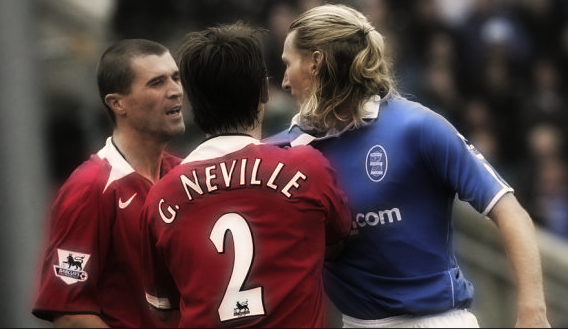 Newcastle's victory against Liverpool provided a welcome tonic for under fire boss Steve McClaren who, when asked about his players, reflected: "They've just proved the harder you work the luckier you get." Sky analyst Thierry Henry agreed "When you work hard in the game, the ball will always go your way." Anchorman Ed Chamberlain rounded off the broadcast with another firm statement: "Newcastle were absolutely brilliant." Week in, week out, the general narrative around teams is built by surface observations and confirmed by results. The idea here, that because Newcastle worked hard, they deserved to win is relatively simple to deconstruct. The game that most observers watched was pretty poor and neither team managed to create an adequate volume of chances to score. A combined sixteen shots makes this an extremely low event game and suggests that defences had the upper hand. A deflection, so luck, was decisive for Newcastle's first and a second goal came late in stoppage time, by which point the match had entered a zone in which a chasing defence necessarily shifts its emphasis; the reward for risk becomes high and immediate and the punishment for failure irrelevant. In reality, the game was hugely influenced by Liverpool's strengths and inadequacies. Their strength, a view that is irretrievably punctured by the concession of two goals, was in defence. In limiting Newcastle to six shots all game and prior to the Wijnaldum cherry, zero shots on target, they can be complimented for achieving a structure that will usually achieve their goal- a clean sheet. In contrast, their weakness was failing to test the opposition goalkeeper sufficiently with the chances they created and a failure to create a greater volume of chances. Newcastle can get some credit for the latter but it stops short of being feasibly described as "brilliant". But what of hard work creating luck? This belief was parroted by all and sundry as if it was the magic key to Newcastle's game. A quick search finds that many great minds have espoused this opinion and some have even found their thought transposed onto a meadowed background and shared widely around social media. We also often hear successful people cite the hard work they put in as a key contributor to their success. (Hard work put in by those less successful is rarely noted.) However, in this specific situation we have a scenario in which two professional sports teams from the same league were competing for a common goal. Not only that but Newcastle's opponents have been widely cited as a team that "works hard" thanks to the known style of their coach. Earlier on in the season, Liverpool became the first team to outrun another "hard-working" team in Tottenham and Match of the Day 2, who have in recent months endeavoured to broaden their analyses, noted how Liverpool "worked as hard" against Newcastle as any other Klopp fixture. But maybe working hard isn't quite the key indicator? As an aside, often, the first thing a new coach promises that he will do is to get his players "working hard", as if to say that the previous incumbent had failed in this task. It plays well with fans and capitalists, with the implication that a prescription for winning involves a simple increase in effort. The problem here is that there is no evidence that an increase beyond a certain level in physical effort has any influence on success. There is obviously a baseline for "amount of effort required" or else a team will simply be outmatched but at best it can be described as a stylistic measure. The influencers for success are actually found elsewhere, largely in talent and to a lesser degree in systems and luck. Anyway, if Sturridge finishes his chance or Moreno gets a break, then inevitably we will find that Liverpool worked hard and "deserved" to win. The margins between two professional football teams competing solidly are necessarily small. Victory need not equate to brilliance, or even praise if the process is faulty, for replication may not be forthcoming. Newcastle won the day but the reason was more closely related to random variation than hard work. A good result masked an inability to be sufficiently creative; a problem they have found all year. None of this is anything more than a simple considered reflection of the game and why this is relevant now is that as armchair fans, this week we have lost the chief visible anchor for smart analysis. Most popular football coverage severely lacks what has made Monday Night Football great; most of it is instantly reactive in the aftermath of a game, is ill-conceived and relies on cliche, monotony and throwaway opinions. MNF and Gary Neville's roles were different. You knew that either he, Jamie Carragher or analysts working on the show had attempted to look beyond the surface of the weekend's games to find nuanced opinions and truths about what they had seen. As lifelong one-club men, on occasion their analysis could be blinkered by the limitations of their world view but in television's scorching desert of hot takes, the show and particularly Neville's contribution stood out. This is not about the promotion of analytics or tactical analysis in themselves. Millions of people bet regularly, play fantasy games or watch every game their team plays. These people consume huge amounts of information about the sport and their teams and are currently poorly served by widespread generic TV analysis. All we can ask for is considered opinion and if backed up by tangible facts, all the better. Neville's shoes are big and Sky should feel obliged to maintain the level of their flagship football show. Let's hope they do. Stoke come to life in an otherwise inept week Title contenders Arsenal, Leicester and Watford get a free pass here having continued their strong form with routine wins. Elsewhere the might of Man Utd, Liverpool and Tottenham created a combined total of five shots on target against West Ham, Newcastle and West Brom, and Chelsea added being reasonably unlucky to their list of inadequacies. After seeing the last two weeks draw analytical attention first for Tottenham and then Man Utd, this week is prime for a new team to enter the fray and with exceptional timing Stoke comfortably fended off an injury affected and underperforming Man City. Stoke have had a strange season. Any team which can surround a defeat to Sunderland with victories against Chelsea, Southampton and Man City deserves further investigation and largely because of these eyecatching results, potential analysis has moved from a shrug to a raised eyebrow. They sit tenth and don't concede much, which seems fine but sit joint last for goals scored which isn't. Under the hood, it isn't looking too healthy with a season total of -5.1 shots per game and the avoidance of trouble being propped up by a now league high save percentage of over 80%. Contributing to games with few goals, Stoke's opposition are also preventing them scoring at a high rate–75%–and only four of their fifteen games have involved both teams scoring, including none of the last eight. Considering Stoke broadly matched their expectation based on their shooting last year and invested ambitiously, it seems jarring to see us faced with what looks like it might be a lesser team. Their position this year looks similar to last year but this time they are over performing against sub par numbers. In fact, by my reckoning their level of overperformance is rivaling that of Leicester. I've got them both about six points ahead of expectation but when that takes you to a level the wider world pegs you at regardless, nobody notices. Crazily all this looks a bit Tony Pulis: dismal shot numbers with decent results and of course he is at it again at West Brom. Two and a half years on and with a complete refit done, Stoke are by some measures, very much still Stoke. The hope has to be that these good recent results signify the start of the new parts gelling, the intricate skills of Bojan and Shaqiri can continue to feed Arnautovic and their early form has been a function of new players taking time to settle. For now though, that's pure speculation.
Newcastle's victory against Liverpool provided a welcome tonic for under fire boss Steve McClaren who, when asked about his players, reflected: "They've just proved the harder you work the luckier you get." Sky analyst Thierry Henry agreed "When you work hard in the game, the ball will always go your way." Anchorman Ed Chamberlain rounded off the broadcast with another firm statement: "Newcastle were absolutely brilliant." Week in, week out, the general narrative around teams is built by surface observations and confirmed by results. The idea here, that because Newcastle worked hard, they deserved to win is relatively simple to deconstruct. The game that most observers watched was pretty poor and neither team managed to create an adequate volume of chances to score. A combined sixteen shots makes this an extremely low event game and suggests that defences had the upper hand. A deflection, so luck, was decisive for Newcastle's first and a second goal came late in stoppage time, by which point the match had entered a zone in which a chasing defence necessarily shifts its emphasis; the reward for risk becomes high and immediate and the punishment for failure irrelevant. In reality, the game was hugely influenced by Liverpool's strengths and inadequacies. Their strength, a view that is irretrievably punctured by the concession of two goals, was in defence. In limiting Newcastle to six shots all game and prior to the Wijnaldum cherry, zero shots on target, they can be complimented for achieving a structure that will usually achieve their goal- a clean sheet. In contrast, their weakness was failing to test the opposition goalkeeper sufficiently with the chances they created and a failure to create a greater volume of chances. Newcastle can get some credit for the latter but it stops short of being feasibly described as "brilliant". But what of hard work creating luck? This belief was parroted by all and sundry as if it was the magic key to Newcastle's game. A quick search finds that many great minds have espoused this opinion and some have even found their thought transposed onto a meadowed background and shared widely around social media. We also often hear successful people cite the hard work they put in as a key contributor to their success. (Hard work put in by those less successful is rarely noted.) However, in this specific situation we have a scenario in which two professional sports teams from the same league were competing for a common goal. Not only that but Newcastle's opponents have been widely cited as a team that "works hard" thanks to the known style of their coach. Earlier on in the season, Liverpool became the first team to outrun another "hard-working" team in Tottenham and Match of the Day 2, who have in recent months endeavoured to broaden their analyses, noted how Liverpool "worked as hard" against Newcastle as any other Klopp fixture. But maybe working hard isn't quite the key indicator? As an aside, often, the first thing a new coach promises that he will do is to get his players "working hard", as if to say that the previous incumbent had failed in this task. It plays well with fans and capitalists, with the implication that a prescription for winning involves a simple increase in effort. The problem here is that there is no evidence that an increase beyond a certain level in physical effort has any influence on success. There is obviously a baseline for "amount of effort required" or else a team will simply be outmatched but at best it can be described as a stylistic measure. The influencers for success are actually found elsewhere, largely in talent and to a lesser degree in systems and luck. Anyway, if Sturridge finishes his chance or Moreno gets a break, then inevitably we will find that Liverpool worked hard and "deserved" to win. The margins between two professional football teams competing solidly are necessarily small. Victory need not equate to brilliance, or even praise if the process is faulty, for replication may not be forthcoming. Newcastle won the day but the reason was more closely related to random variation than hard work. A good result masked an inability to be sufficiently creative; a problem they have found all year. None of this is anything more than a simple considered reflection of the game and why this is relevant now is that as armchair fans, this week we have lost the chief visible anchor for smart analysis. Most popular football coverage severely lacks what has made Monday Night Football great; most of it is instantly reactive in the aftermath of a game, is ill-conceived and relies on cliche, monotony and throwaway opinions. MNF and Gary Neville's roles were different. You knew that either he, Jamie Carragher or analysts working on the show had attempted to look beyond the surface of the weekend's games to find nuanced opinions and truths about what they had seen. As lifelong one-club men, on occasion their analysis could be blinkered by the limitations of their world view but in television's scorching desert of hot takes, the show and particularly Neville's contribution stood out. This is not about the promotion of analytics or tactical analysis in themselves. Millions of people bet regularly, play fantasy games or watch every game their team plays. These people consume huge amounts of information about the sport and their teams and are currently poorly served by widespread generic TV analysis. All we can ask for is considered opinion and if backed up by tangible facts, all the better. Neville's shoes are big and Sky should feel obliged to maintain the level of their flagship football show. Let's hope they do. Stoke come to life in an otherwise inept week Title contenders Arsenal, Leicester and Watford get a free pass here having continued their strong form with routine wins. Elsewhere the might of Man Utd, Liverpool and Tottenham created a combined total of five shots on target against West Ham, Newcastle and West Brom, and Chelsea added being reasonably unlucky to their list of inadequacies. After seeing the last two weeks draw analytical attention first for Tottenham and then Man Utd, this week is prime for a new team to enter the fray and with exceptional timing Stoke comfortably fended off an injury affected and underperforming Man City. Stoke have had a strange season. Any team which can surround a defeat to Sunderland with victories against Chelsea, Southampton and Man City deserves further investigation and largely because of these eyecatching results, potential analysis has moved from a shrug to a raised eyebrow. They sit tenth and don't concede much, which seems fine but sit joint last for goals scored which isn't. Under the hood, it isn't looking too healthy with a season total of -5.1 shots per game and the avoidance of trouble being propped up by a now league high save percentage of over 80%. Contributing to games with few goals, Stoke's opposition are also preventing them scoring at a high rate–75%–and only four of their fifteen games have involved both teams scoring, including none of the last eight. Considering Stoke broadly matched their expectation based on their shooting last year and invested ambitiously, it seems jarring to see us faced with what looks like it might be a lesser team. Their position this year looks similar to last year but this time they are over performing against sub par numbers. In fact, by my reckoning their level of overperformance is rivaling that of Leicester. I've got them both about six points ahead of expectation but when that takes you to a level the wider world pegs you at regardless, nobody notices. Crazily all this looks a bit Tony Pulis: dismal shot numbers with decent results and of course he is at it again at West Brom. Two and a half years on and with a complete refit done, Stoke are by some measures, very much still Stoke. The hope has to be that these good recent results signify the start of the new parts gelling, the intricate skills of Bojan and Shaqiri can continue to feed Arnautovic and their early form has been a function of new players taking time to settle. For now though, that's pure speculation. 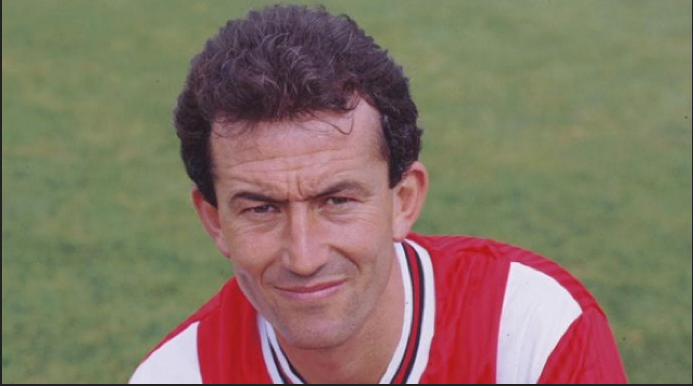 Obligatory Tottenham failure to break down a parked team Pulis once more turned to his one page playbook to thwart Tottenham. Gleefully following the renewed fashion for placing centre backs in central midfield, Jonny Evans found himself in there tasked with "doing a job". and once they had found an equaliser, the game stagnated towards a familiar shape. Over Pochettino's reign, Tottenham have often struggled against a set defence and so it proved again. With limited evidence, it's hard to quantify if this underwhelming attacking effort, much like that against Chelsea, is a function of opposition tactics or if the team has slowed slightly after an energetic early peak. With fixtures in the near future looking generally favourable – the next time they face a moneyed or traditional big club is in February – it is to be hoped that the former is true but as noted by Will Morgan on the Anfield Index podcast and with a heavy caveat for sample size, Pochettino's two full seasons in English football have featured mid-season dips in form. The turnaround through late December is quick and few teams come through unscathed, so this run of fixtures will be a solid test of their top four credentials. ______________________ Thanks for reading Find me on Twitter @jair1970
Obligatory Tottenham failure to break down a parked team Pulis once more turned to his one page playbook to thwart Tottenham. Gleefully following the renewed fashion for placing centre backs in central midfield, Jonny Evans found himself in there tasked with "doing a job". and once they had found an equaliser, the game stagnated towards a familiar shape. Over Pochettino's reign, Tottenham have often struggled against a set defence and so it proved again. With limited evidence, it's hard to quantify if this underwhelming attacking effort, much like that against Chelsea, is a function of opposition tactics or if the team has slowed slightly after an energetic early peak. With fixtures in the near future looking generally favourable – the next time they face a moneyed or traditional big club is in February – it is to be hoped that the former is true but as noted by Will Morgan on the Anfield Index podcast and with a heavy caveat for sample size, Pochettino's two full seasons in English football have featured mid-season dips in form. The turnaround through late December is quick and few teams come through unscathed, so this run of fixtures will be a solid test of their top four credentials. ______________________ Thanks for reading Find me on Twitter @jair1970
Are Tottenham For Real?
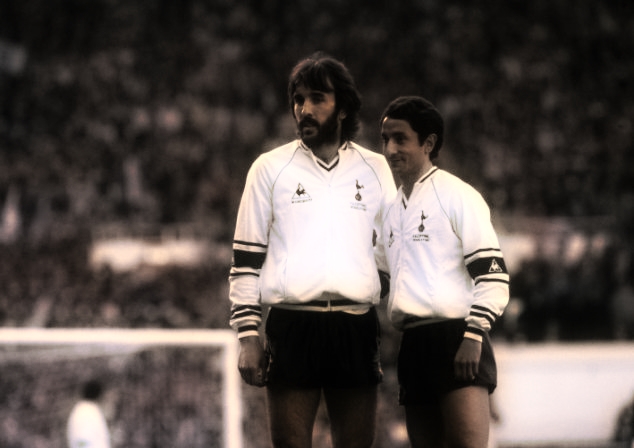 With a litany of false dawns strewn liberally throughout their history, it's easy to adopt a "wait and see" attitude to the potential of Tottenham as a team that can contend at the top end of the table. After the chaos that enveloped the on-pitch activity during much of last season, it was easy to presume that a new dawn was some distance from being realised. Yet here we are in week thirteen of the Premier League and an unexpected threshold has been passed, one which makes it hard to deny that this Tottenham team, if not title contenders in this strange and democratic season, are certainly prime candidates for a top four slot: Tottenham currently lead the league for shots on target. They have 87, City have 86 and Arsenal have 81. A small explainer here is that they also lead the league in the rate in which their shots are landing on target, which is a good enough reason to not instantly proclaim the second coming and allow a genuinely warm but not piping hot appraisal. In itself, this is just one aspect of the game – albeit an important signal— but in a season that has seen Arsenal and Man City variously show extremely impressive attacking verve and deservedly lead projections for the title outright, this pitches Tottenham right among the contending pack as we enter the vital busy second third of the season: December, regular fixtures, no more international breaks, the tail end of European group fixtures, Christmas and beyond. Let's look at a few more numbers: A logical progression means that Paul Riley's Shot on Target xG model shows a close relationship between a top three:
With a litany of false dawns strewn liberally throughout their history, it's easy to adopt a "wait and see" attitude to the potential of Tottenham as a team that can contend at the top end of the table. After the chaos that enveloped the on-pitch activity during much of last season, it was easy to presume that a new dawn was some distance from being realised. Yet here we are in week thirteen of the Premier League and an unexpected threshold has been passed, one which makes it hard to deny that this Tottenham team, if not title contenders in this strange and democratic season, are certainly prime candidates for a top four slot: Tottenham currently lead the league for shots on target. They have 87, City have 86 and Arsenal have 81. A small explainer here is that they also lead the league in the rate in which their shots are landing on target, which is a good enough reason to not instantly proclaim the second coming and allow a genuinely warm but not piping hot appraisal. In itself, this is just one aspect of the game – albeit an important signal— but in a season that has seen Arsenal and Man City variously show extremely impressive attacking verve and deservedly lead projections for the title outright, this pitches Tottenham right among the contending pack as we enter the vital busy second third of the season: December, regular fixtures, no more international breaks, the tail end of European group fixtures, Christmas and beyond. Let's look at a few more numbers: A logical progression means that Paul Riley's Shot on Target xG model shows a close relationship between a top three:
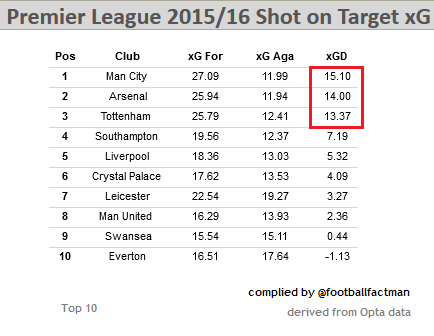 (go here for charts and *new*: data)
(go here for charts and *new*: data)
I've got a bits and bobs variation of James Grayson's Team Rating that pegs them at third. Old archaic metrics such as goals scored (=third), goals conceded (second) and goal difference (second) shape up quite nicely too. This isn't Leicester miraculously landing on top spot having conceded twenty goals in thirteen games yet losing just once. These numbers are solid and have been throughout the season. It's also an endorsement of this more cohesive Tottenham squad that they have managed to consistently out-shoot the opposition. The only matches in which they haven't have been Man Utd, which featured a dour nine shots each, Stoke, in which they wobbled badly late on, and Man City, by which time it was irrelevant. In no other game have they conceded more than four shots on target or thirteen shots, two significant numbers to maintain given they are roughly the average amount required that a team requires to expect to score once. The league leading shot on target total hasn't been accrued by a handful of freak games either, it's it has been generated by consistency: on nine occasions have they managed six or more shots on target, more than Man City (8) and Leicester (7). Time More goodness exists here: only Palace (who have a game in hand) and Man Utd have spent less time losing all year and only West Ham, Man Utd and Arsenal have spent more time in a winning position. In the few minutes spent losing they have a league high on target rate and a league low rate of conceding the same. Conclusions here aren't strong but on the rare occasions they've been behind they've shown fast form to reply and given the only defeat they've met was against the belligerence of Man Utd, no team has successfully taken a lead and dominated them. It's not as if the fixture list has been over generous either having faced four of last year's top seven rivals. Draws So why are Tottenham back in fifth and not elbowing Leicester off the top? All those draws. Back in around September, Harry Kane was down on his luck. To the tabloids he was "begging for a sniff of goal", his "confidence was shot to pieces by repeated failure" and he had resorted to "spending night after night barking "Why?" into a mirror before hauling his sorry but muscular torso back into Tottenham's forward line to limply fire three and half shots per game vaguely towards but not past a series of cackling and smug goalkeepers". Then it changed, almost as if confidence wasn't the real reason behind his brief barren streak, once more the net started to bulge and here we find a eight goal striker in November who leads the league in on target shots: 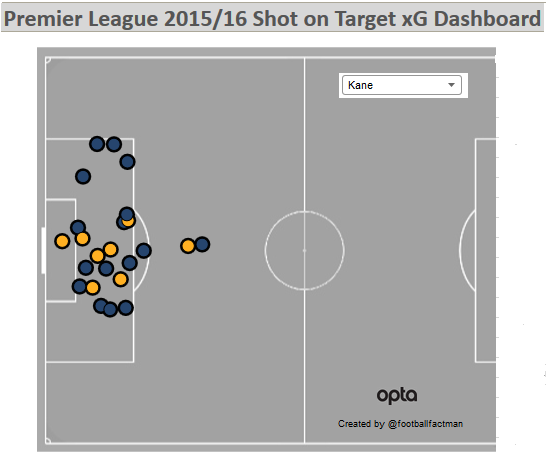
(Find your favourite PL player here)
The upshot of this cold then hot streak has been six draws, at least half of which fall into the "frustrating" category. When your (sole) forward isn't finding the net, results can be hard to come by, just look at Chelsea. So what is against Tottenham at this stage? Set pieces Tottenham are creating and conceding around 3.5 set piece shots per game so far this year: they've scored eight, which leads the league and have conceded only once. This is once more an area where skill or random variation are typically related, insofar as there is very little that can be done to control the levels of conversion here. It's perfectly conceivable to go through a season exceeding your opposition, and by some margin, what isn't possible to predict is whether or not that will happen or continue. Tottenham are right on the sharp end of this going their way, and as ever, in a sport which averages well under three goals per game, a plus seven goal difference here in 13 games is clearly influential. Possible tiredness Anyone who has watched a Tottenham game recently will have noted the frenetic nature of the play. No space in midfield, hard pressing from the attacking midfielders and Dembele shielding the ball as if he's wearing armour. It's pretty relentless stuff and in Pochettino's two seasons in the league his teams haven't managed to keep up this level through until May. Of course given that two is a sample of zero consequence and neither of those seasons were buoyed by the potential of qualifying for the Champions League, it's wrong to be definitive here. Though the squad look largely balanced, and the reinvigoration of players like Walker and Dembele has been welcome, the one glaring hole remains exactly as it was as the transfer window closed: back up for Kane. When the drop off in quality from first to second choice goes from "very good" to "doesn't exist", it's a problem. There are memories tinged with "what might have been?" at Tottenham. Few fans have forgiven Redknapp for his half-baked coast towards the ultimately futile fourth place in 2011-12. Early on in that season, that team looked set for much better as did the one full season from Villas Boas' once Bale had kicked in the turbos. Each ended with a status of nearly but not quite but the hope this time is growing on almost a weekly basis. The forthcoming Chelsea game, though shorn of darling of the week Alli, has the potential to define a perception already boosted by the widely seen destruction of West Ham. Taking the lead Simple truths exist within simple measurements: 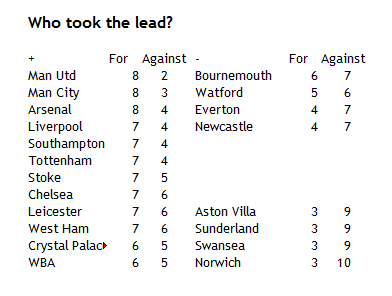 All defined from the first goal of the match, if indeed one was scored. Analysis can be short here, in fact it can be realistically rounded down to one word, which may be a record. Anyway: Swansea. City v Liverpool
All defined from the first goal of the match, if indeed one was scored. Analysis can be short here, in fact it can be realistically rounded down to one word, which may be a record. Anyway: Swansea. City v Liverpool
In the last 20 league games Man City have conceded 4 on three occasions, against van Gaal's press, the Poch press and the Klopp press.
— James Yorke (@jair1970) November 21, 2015
As you can see some wiseguy decided he had noted a pattern in Man City's more dispiriting recent defeats: they keep getting turned over by teams that press them. That Klopp should be getting as clear a tune as he could have wished for from a strikerless eleven gave his methods a tidy endorsement but before anyone gets too carried away with what was an exhilarating first half demolition, it should be noted that this was one of those "nearly all the shots went in" starts to a game. Man Utd did similar in a 3-0 win against Tottenham towards the end of last season and once a logically unassailable lead has been achieved, it's quite normal for games to take on a unique personality: either nothing at all happens or the strangeness continues. Man City were so bad here – and this kind of performance is becoming frustrating when held against their overall qualities – that it's hard not to frame it against the forthcoming crucial Juventus tie. Regardless, Pellegrini looked outsmarted once more and maybe felt pressure in playing at home. It had seemed that he'd learned how to deal with pressing in the non-event 0-0 against Utd last month, but at the Etihad, those tactics weren't employed and with such pragmatism absent, familiar concerns about the long term solutions to City's central midfield once more returned. Liverpool's quick resurgence has been powered by incredibly similar shot numbers between Rodgers' last five games and the five under Klopp: 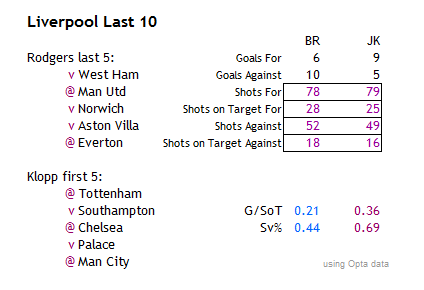 Brendan got five points from that lot and Jürgen managed eight though he has had notably more difficult fixtures. Now, with Firmino looking like he could be the £30m player that they hoped for and now two big victories away against money clubs, the ship looks like it's being steered away from the icebergs that Rodgers found at every turn. Regardless, it could have got no worse for Brendan, he left at a low point for goal prevention and the building blocks of a useful team were already in place. Klopp's arrival if followed by success, combined with still strong challenges from van Gaal's Utd team and Pochettino at Tottenham, offers a large enough cabal of teams to potentially affect the league and wider perception towards style. With English teams ever conservative in comparison to the better teams on the continent, the rise of these pressing outfits could well be close to a tipping point. We shall see. ________________ Thanks for reading @jair1970
Brendan got five points from that lot and Jürgen managed eight though he has had notably more difficult fixtures. Now, with Firmino looking like he could be the £30m player that they hoped for and now two big victories away against money clubs, the ship looks like it's being steered away from the icebergs that Rodgers found at every turn. Regardless, it could have got no worse for Brendan, he left at a low point for goal prevention and the building blocks of a useful team were already in place. Klopp's arrival if followed by success, combined with still strong challenges from van Gaal's Utd team and Pochettino at Tottenham, offers a large enough cabal of teams to potentially affect the league and wider perception towards style. With English teams ever conservative in comparison to the better teams on the continent, the rise of these pressing outfits could well be close to a tipping point. We shall see. ________________ Thanks for reading @jair1970
Why Have Juventus Struggled?
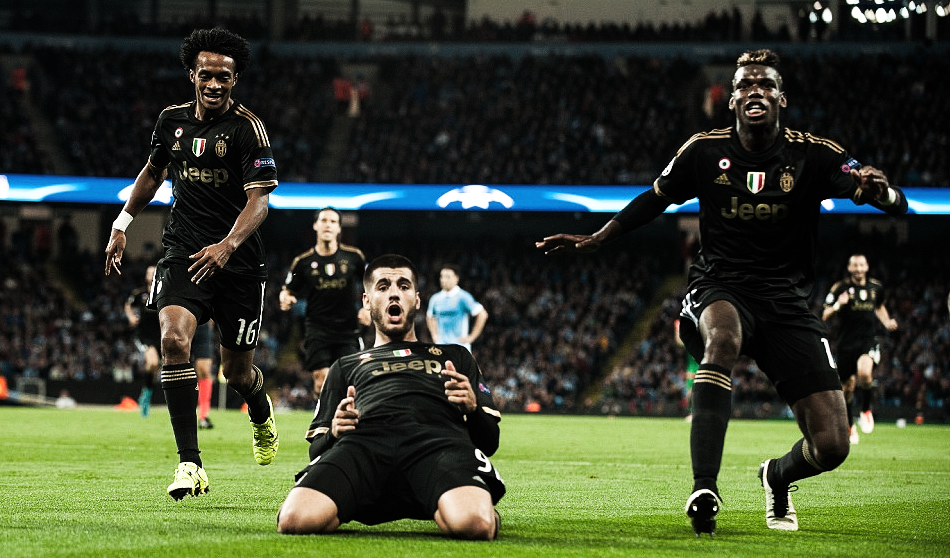 A good price? Of the big five European leagues last year, Juventus won their league by the largest margin. By creating a 17 point gap over Roma in raw point terms they were more convincing than Bayern (ten point gap), PSG (eight points), Chelsea (eight points) and Barcelona (two points). Onto this season and around the top European leagues you might expect a coin flip in Spain and at least that in England, but the other three leagues seemed far more likely to return the incumbents to their throne. Yet, during pre-season we had disparity in bookmakers' prices. Both Bayern and PSG started their seasons at prohibitively short odds of around 1.10 (1/10) where Juventus were significantly longer at 1.66 (4/6). Why would this be so? Juventus had won the four previous titles, and had a ridiculously solid defence that hadn't conceded any significant volume of goals throughout (20, 24, 23, 24). Their attack had also scored more than adequately each year (68, 71, 80, 72). Fresh from a Champions League final, surely they looked set to continue their dominance? This was a team that had dominated its league, so why were we looking at a set of odds that could tempt? If we do a calculation to derive an expected points total from shot and rate numbers over their title streak we find this:
A good price? Of the big five European leagues last year, Juventus won their league by the largest margin. By creating a 17 point gap over Roma in raw point terms they were more convincing than Bayern (ten point gap), PSG (eight points), Chelsea (eight points) and Barcelona (two points). Onto this season and around the top European leagues you might expect a coin flip in Spain and at least that in England, but the other three leagues seemed far more likely to return the incumbents to their throne. Yet, during pre-season we had disparity in bookmakers' prices. Both Bayern and PSG started their seasons at prohibitively short odds of around 1.10 (1/10) where Juventus were significantly longer at 1.66 (4/6). Why would this be so? Juventus had won the four previous titles, and had a ridiculously solid defence that hadn't conceded any significant volume of goals throughout (20, 24, 23, 24). Their attack had also scored more than adequately each year (68, 71, 80, 72). Fresh from a Champions League final, surely they looked set to continue their dominance? This was a team that had dominated its league, so why were we looking at a set of odds that could tempt? If we do a calculation to derive an expected points total from shot and rate numbers over their title streak we find this: 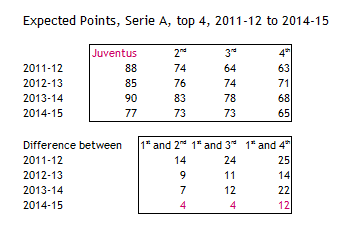 Methods here can vary but by calculating this rather than using the actual point totals we find a more reliable method of understanding the true quality of a team. Here we have some insight into the difference between what might have seemed to be generous odds from the bookmakers and a more casual perception that a team that had just won it's league by 17 points should be a prohibitively short price. The 2014-15 Juventus team was the best team in it's league, it just wasn't worth +17 points against its rivals or in front of the second or third rated teams by a very large margin in comparison to previous years. Still, understandably they remained favourites for the title throughout pre-season and there was a clear onus on other teams to improve to stand a chance of dethroning them; Roma have had good sides in previous years, as have Napoli and teams such as Lazio, Inter or Fiorentina could have some hope to build. What they may not have expected was the weird chaos to envelop early results of the bianconeri and as we reside here in mid-November, Bayern and PSG are coasting along leaving a trail of debris in their wake and Juventus are er... 7th. On the surface there may seem to be similarities with another malaise stricken European giant but where Chelsea's performances have broadly pegged them at a position similar to where they reside, Juventus can consider themselves to have been somewhat unfortunate to have found themselves on the lower fringe of contention. Shots good, conversions bad So what's happened to them? This is a team that had only lost ten matches in four seasons and has now been defeated four times in just twelve games. If the 2014-15 side was the weakest of their championship winning teams, then how strong is the 2015-16 iteration? There are a variety of expected goals models floating about but Michael Caley produces a variety of advanced stats for the big European leagues and his model places Juventus first. We can also get a broad understanding from their shot totals and looking at them we can see they rank first for shots +/- and third for shots on target +/-. Whichever way you choose to look at their shooting numbers, the implication is clear: at worst this looks like a top four team, at best they are good enough to lead the league. Where we have found a new Juventus is in their current inability to rebut shots and a high level of their own wasteful shooting:
Methods here can vary but by calculating this rather than using the actual point totals we find a more reliable method of understanding the true quality of a team. Here we have some insight into the difference between what might have seemed to be generous odds from the bookmakers and a more casual perception that a team that had just won it's league by 17 points should be a prohibitively short price. The 2014-15 Juventus team was the best team in it's league, it just wasn't worth +17 points against its rivals or in front of the second or third rated teams by a very large margin in comparison to previous years. Still, understandably they remained favourites for the title throughout pre-season and there was a clear onus on other teams to improve to stand a chance of dethroning them; Roma have had good sides in previous years, as have Napoli and teams such as Lazio, Inter or Fiorentina could have some hope to build. What they may not have expected was the weird chaos to envelop early results of the bianconeri and as we reside here in mid-November, Bayern and PSG are coasting along leaving a trail of debris in their wake and Juventus are er... 7th. On the surface there may seem to be similarities with another malaise stricken European giant but where Chelsea's performances have broadly pegged them at a position similar to where they reside, Juventus can consider themselves to have been somewhat unfortunate to have found themselves on the lower fringe of contention. Shots good, conversions bad So what's happened to them? This is a team that had only lost ten matches in four seasons and has now been defeated four times in just twelve games. If the 2014-15 side was the weakest of their championship winning teams, then how strong is the 2015-16 iteration? There are a variety of expected goals models floating about but Michael Caley produces a variety of advanced stats for the big European leagues and his model places Juventus first. We can also get a broad understanding from their shot totals and looking at them we can see they rank first for shots +/- and third for shots on target +/-. Whichever way you choose to look at their shooting numbers, the implication is clear: at worst this looks like a top four team, at best they are good enough to lead the league. Where we have found a new Juventus is in their current inability to rebut shots and a high level of their own wasteful shooting: 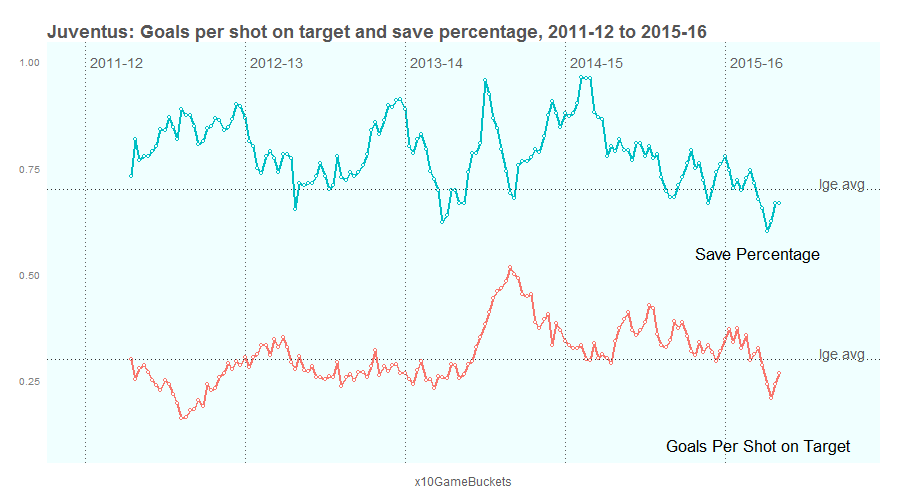 Now these metrics are known to regress over time and do not intrinsically represent the true quality of the team. We can see here that it is extremely rare for Juventus to perform at below league average levels for both metrics at the same time, as is the case in the early weeks of this season. Indeed the last time it occurred was in the early stages of 2013-14 and it was followed by the most extreme skew in the chart for both metrics. That year they won 33 games, got 102 points and managed a 12 then later a seven game win streak. It's worth remembering that these less consistent metrics can run extremely hot, as described here and extremely cold, as we are now seeing. Also throughout the Championship seasons those strong defensive numbers were assisted by a series of high save percentages: 2011-12: 81%, 2012-13: 78%, 2013-14: 81% and 2014-15: 76%. Through twelve games in 2015-16, Juventus' have conceded almost half as many goals as they had in each of the last four seasons and their save percentage is significantly lower at 67%. They have been heavy shooters this year- but primarily at home. In six games at home, they have an incredibly high +100 shot differential over their opponents. That they have failed to convert this absolute dominance into more points seems somewhat of a quirk- conceding five times to only twelve shots on target here hasn't helped and only 6.5% of all their shots have gone in- a low total. Away from home they have faced their three most difficult fixtures, at Napoli, Roma and Inter, and have gained only one point from what transpired to be closely matched games. With these games combined with their other fixtures, away from the Stadium they have been only a par shots team. Groups Juve's fixtures can be broadly grouped into three: routine wins- of which there are five, the aforementioned away games against rivals and four superficially baffling results against lesser teams. This last group is most interesting here as it is the least obviously explainable:
Now these metrics are known to regress over time and do not intrinsically represent the true quality of the team. We can see here that it is extremely rare for Juventus to perform at below league average levels for both metrics at the same time, as is the case in the early weeks of this season. Indeed the last time it occurred was in the early stages of 2013-14 and it was followed by the most extreme skew in the chart for both metrics. That year they won 33 games, got 102 points and managed a 12 then later a seven game win streak. It's worth remembering that these less consistent metrics can run extremely hot, as described here and extremely cold, as we are now seeing. Also throughout the Championship seasons those strong defensive numbers were assisted by a series of high save percentages: 2011-12: 81%, 2012-13: 78%, 2013-14: 81% and 2014-15: 76%. Through twelve games in 2015-16, Juventus' have conceded almost half as many goals as they had in each of the last four seasons and their save percentage is significantly lower at 67%. They have been heavy shooters this year- but primarily at home. In six games at home, they have an incredibly high +100 shot differential over their opponents. That they have failed to convert this absolute dominance into more points seems somewhat of a quirk- conceding five times to only twelve shots on target here hasn't helped and only 6.5% of all their shots have gone in- a low total. Away from home they have faced their three most difficult fixtures, at Napoli, Roma and Inter, and have gained only one point from what transpired to be closely matched games. With these games combined with their other fixtures, away from the Stadium they have been only a par shots team. Groups Juve's fixtures can be broadly grouped into three: routine wins- of which there are five, the aforementioned away games against rivals and four superficially baffling results against lesser teams. This last group is most interesting here as it is the least obviously explainable: 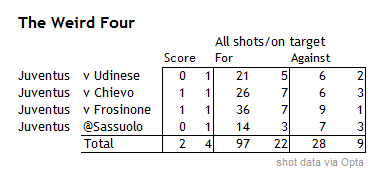 In each of these games they have dominated yet conceded and failed to win. To have scored twice from 97 shots here is a phenomenal underperformance. Beyond this, they have only managed clean sheets in three of their opening twelve matches (compared to 9/12 last season). Defense coherence So what kind of goals are Juventus now conceding? Is there anything within their construction that can prove informative? Having turned to the video, it's possible to create an argument that they have been conceding a combination of brilliant free kicks and defensively questionable goals, the first of which, in themselves are hard to counter, the latter implies that this defense hasn't the solidity of prior years:
In each of these games they have dominated yet conceded and failed to win. To have scored twice from 97 shots here is a phenomenal underperformance. Beyond this, they have only managed clean sheets in three of their opening twelve matches (compared to 9/12 last season). Defense coherence So what kind of goals are Juventus now conceding? Is there anything within their construction that can prove informative? Having turned to the video, it's possible to create an argument that they have been conceding a combination of brilliant free kicks and defensively questionable goals, the first of which, in themselves are hard to counter, the latter implies that this defense hasn't the solidity of prior years:
- v Udinese: deep cross, untracked runner on back post converts, keeper no chance
- @ Roma: Free kick, keeper rooted, unstoppable
- @ Roma: looping cross, defender outmuscled, close header, keeper no chance
- v Chievo: deflected cross, defence all run in, lands at feet of unmarked runner 25 yards out, clear shot, swerved away from keeper
- v Frosinone: corner, scorer pushes defending man to make space, close header, keeper no chance
- @ Napoli: no pressure on attacker, one-two to edge of box, clear shot slotted past keeper, keeper maybe slow to ground
- @ Napoli: ball breaks cheaply in midfield, attacker advances simply into left channel under no pressure, powerful shot touched but not kept out by keeper
- v Bologna: ball over defence, entirely untracked runner, finish straight at keeper, unable to keep out, error
- @ Sassuolo: Free kick, keeper rooted, unstoppable
- v Torino: Free kick, blocked by wall, lashed in by taker with other foot
- @ Empoli: hurried sliced clearance falls to attacker who advances unchallenged to edge of box then finds corner.
By my reckoning, that's three free kicks- including the rebounded effort- and eight goals that can be simply criticised from a defensive standpoint. Arguably, to concede free kicks in possible scoring positions is a similar failing. So, where Juventus have conceded a small volume of shots, those that have been conceded and caused greatest problems have implied issues within the structure of the team. Why so? An unsettled side This is the team that started the Champions League final against Barcelona earlier this year: 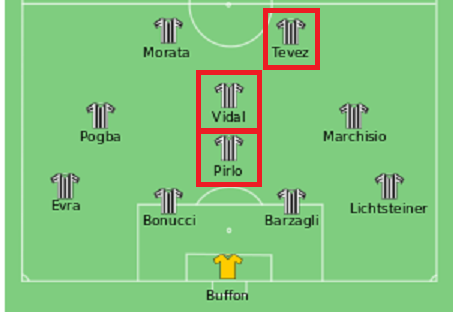 It doesn't take advanced analysis to work out that losing the three players highlighted might have an impact on a team. None of the three need any introduction but suffice to say that Pirlo and Vidal joined Juventus during the same summer in advance of the title runs and were huge contributors to each of the four Scudetto seasons. Not only in their general play and numerical contribution but in the key central part of the team as tempo setters and influencers. Even as Pirlo's in-game influence may have declined, it is reasonable to assume as a highly decorated and respected professional, he would have been a presence around the club and involved with wider team issues. Organisations can often take time to readjust after big contributors have moved on, football is no different. Tevez, ever infusive and a genuinely elite striker had two seasons in which he averaged a shot contribution of over six per game, a goal contribution of around 0.9 per game and a goal scoring record of around 0.6 per game. These are numbers that are difficult to replace. Of that front six above, only Pogba has contributed significant minutes this season (96%). Indeed, Juventus have struggled to get a consistent first team onto the pitch: he is the only midfielder or forward to have featured for more than 65% of available minutes. The team has been far from settled:
It doesn't take advanced analysis to work out that losing the three players highlighted might have an impact on a team. None of the three need any introduction but suffice to say that Pirlo and Vidal joined Juventus during the same summer in advance of the title runs and were huge contributors to each of the four Scudetto seasons. Not only in their general play and numerical contribution but in the key central part of the team as tempo setters and influencers. Even as Pirlo's in-game influence may have declined, it is reasonable to assume as a highly decorated and respected professional, he would have been a presence around the club and involved with wider team issues. Organisations can often take time to readjust after big contributors have moved on, football is no different. Tevez, ever infusive and a genuinely elite striker had two seasons in which he averaged a shot contribution of over six per game, a goal contribution of around 0.9 per game and a goal scoring record of around 0.6 per game. These are numbers that are difficult to replace. Of that front six above, only Pogba has contributed significant minutes this season (96%). Indeed, Juventus have struggled to get a consistent first team onto the pitch: he is the only midfielder or forward to have featured for more than 65% of available minutes. The team has been far from settled: 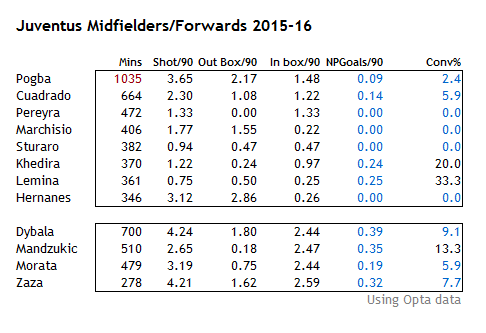 The defense is aging- but the players that have inhabited the zone in front of the centre back have been various and likely inferior to the peak 2014-15 team. Bar one start against Chievo, Marchisio has only featured more recently as form and results have improved, as has Khedira. Early disappointments seem to feature Pogba + Sturaro or Lemina or Hernanes. This looks to have been a team in transition, with personnel issues. Lots of squad men, hard to choose starters. Nobody has managed to get on a run of scoring either, Dybala has three non-penalty goals, Mandzukic has two, others no more than one and it follows that conversion rates are generally poor. Again the question is: who is preferred? Alongside this it appears a variety of formations have been tried. Allegri hasn't been afraid to experiment, but in chopping and changing personnel and formation, he has allowed vulnerabilities to creep into the team's play. Shot Structure We can see some of the changes in subtle differences in the shot structure of the team. Juventus' in-box shots are finding the target at a rate of only 40% (down from 58% last year and well under league average of 46%). The rate in which the opposition is finding the target- 32%- is around league average, however the percentage is the same both inside and outside the box meaning a huge rate of long range shots are finding the target. And they have been going in. One of the starkest contrasts I found was that Juventus scored 22 times from outside the box last season and conceded only four (three for and one against were direct free kicks). This year they have already conceded six times from range while scoring only three (0:2 for direct free kicks). Only Milan have conceded as many and only they have a worse save rate for such shots. This is where I find an analytical quandary, because typically you might expect that this high rate would cool off and a more balanced profile would emerge, but having analysed the goals conceded, I feel that there is a likelihood that the rotation of personnel has had an impact on turning what was a solid defensive unit into what we see now- a good team but one with vulnerabilities. This is where there is a need to find a balance. Some factors can be solidly attributed to a numerical dissection, whereas others require more nuance. Here we see the benefit of looking at a variety of influences to form an analysis, multiple factors are involved in the success or failure of a team's methods and it's simply not sufficient to conclude that "Juventus are the best team in the league, but have been unlucky or affected by random variation". And so... It is most likely that Juve will find a stability in team selection as time goes on and it will help their results, indeed they are 3-1-0, and have looked generally more solid with Khedira, Marchisio and Pogba starting together as a unit and this is all within the last five games. Their two hardest fixtures- at Roma and Napoli- are behind them and they were competitive in each. They are unlikely to fail to win many more matches in which they take 25+ shots and it is unwise to be negative about a squad that has such wide talent within the league. Also unlikely to continue, at least at the rate it has been up until now, is the rate in which they have fallen behind. Having taken the lead in only four of twelve fixtures and fallen behind in seven- and five times within half an hour- they have been faced with frequent deficits to overcome. To some degree this has powered what appear to be extremely strong shooting numbers, a bias that cannot be ignored. The Scudetto might be beyond them this time, and the slight caution from the bookmakers may well have been shrewd. This Juventus team remains a good one, but it probably isn't as great as those that went before. The Serie A title race looks to be one of the more open that we have seen in recent years and all the better for that. __________ Thanks for reading Find me on twitter here: @jair1970
The defense is aging- but the players that have inhabited the zone in front of the centre back have been various and likely inferior to the peak 2014-15 team. Bar one start against Chievo, Marchisio has only featured more recently as form and results have improved, as has Khedira. Early disappointments seem to feature Pogba + Sturaro or Lemina or Hernanes. This looks to have been a team in transition, with personnel issues. Lots of squad men, hard to choose starters. Nobody has managed to get on a run of scoring either, Dybala has three non-penalty goals, Mandzukic has two, others no more than one and it follows that conversion rates are generally poor. Again the question is: who is preferred? Alongside this it appears a variety of formations have been tried. Allegri hasn't been afraid to experiment, but in chopping and changing personnel and formation, he has allowed vulnerabilities to creep into the team's play. Shot Structure We can see some of the changes in subtle differences in the shot structure of the team. Juventus' in-box shots are finding the target at a rate of only 40% (down from 58% last year and well under league average of 46%). The rate in which the opposition is finding the target- 32%- is around league average, however the percentage is the same both inside and outside the box meaning a huge rate of long range shots are finding the target. And they have been going in. One of the starkest contrasts I found was that Juventus scored 22 times from outside the box last season and conceded only four (three for and one against were direct free kicks). This year they have already conceded six times from range while scoring only three (0:2 for direct free kicks). Only Milan have conceded as many and only they have a worse save rate for such shots. This is where I find an analytical quandary, because typically you might expect that this high rate would cool off and a more balanced profile would emerge, but having analysed the goals conceded, I feel that there is a likelihood that the rotation of personnel has had an impact on turning what was a solid defensive unit into what we see now- a good team but one with vulnerabilities. This is where there is a need to find a balance. Some factors can be solidly attributed to a numerical dissection, whereas others require more nuance. Here we see the benefit of looking at a variety of influences to form an analysis, multiple factors are involved in the success or failure of a team's methods and it's simply not sufficient to conclude that "Juventus are the best team in the league, but have been unlucky or affected by random variation". And so... It is most likely that Juve will find a stability in team selection as time goes on and it will help their results, indeed they are 3-1-0, and have looked generally more solid with Khedira, Marchisio and Pogba starting together as a unit and this is all within the last five games. Their two hardest fixtures- at Roma and Napoli- are behind them and they were competitive in each. They are unlikely to fail to win many more matches in which they take 25+ shots and it is unwise to be negative about a squad that has such wide talent within the league. Also unlikely to continue, at least at the rate it has been up until now, is the rate in which they have fallen behind. Having taken the lead in only four of twelve fixtures and fallen behind in seven- and five times within half an hour- they have been faced with frequent deficits to overcome. To some degree this has powered what appear to be extremely strong shooting numbers, a bias that cannot be ignored. The Scudetto might be beyond them this time, and the slight caution from the bookmakers may well have been shrewd. This Juventus team remains a good one, but it probably isn't as great as those that went before. The Serie A title race looks to be one of the more open that we have seen in recent years and all the better for that. __________ Thanks for reading Find me on twitter here: @jair1970
The Bad Times Will Pass: Brendan Rodgers, Confidence And Misfiring Forwards
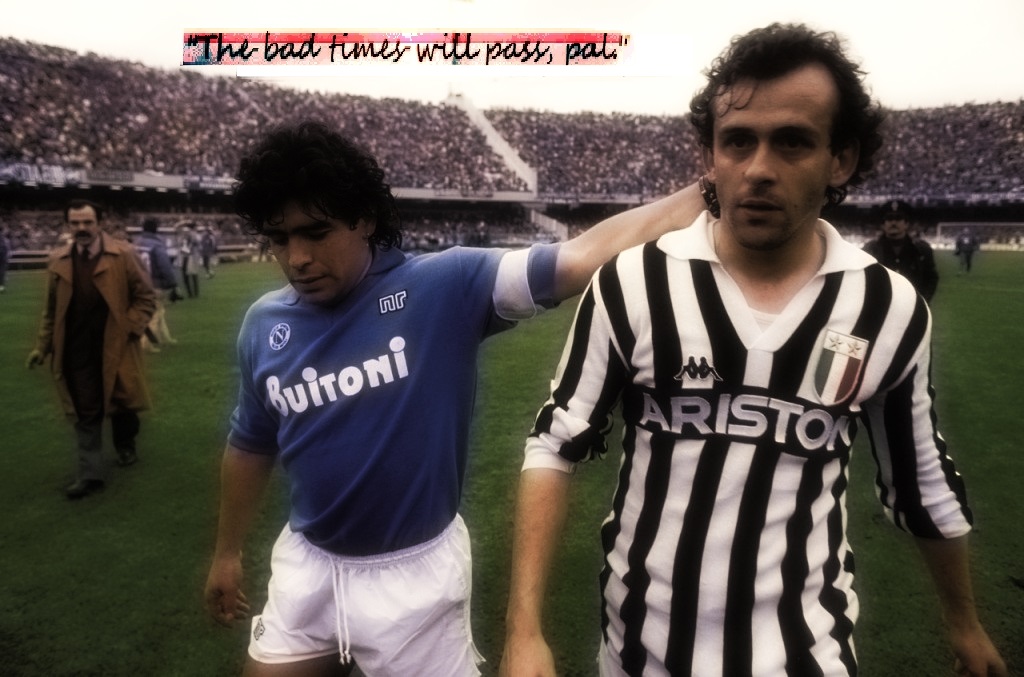 It was one of those weekends. Goals everywhere, shots aplenty and in some regard reversion to the old order. In itself, Saturday was a match day like few before it. We've seen plenty of goals before but rarely, if ever, have we seen so many shots land on target. The season average across the league is 4.5 per team per game and Saturday offered up 6.7 each. I've checked back and I can find no weekend any higher than 5.9 across six seasons, so it was a tough week for goalkeepers to earn their corn. It was inevitable that Palace and Watford would play a grindy match on Sunday that brought the average down. But still... Maybe it was the weird conjunction of a lunar eclipse and a super moon, and now civilisation is hanging by a thread and you're reading this in a bunker, wondering how the internet is still functioning despite the apocalyptic scenes outside? Or maybe sport just does this kind of thing sometimes and is best enjoyed as the genuinely lunatic spectacle it can sometimes be. Regardless, amongst the chaos a fair few inevitable events took place. After noting last week how other than United, all of last year's top seven had been under-performing in shot conversions, the four chief strugglers all perked up. Liverpool netted thrice, as did Southampton, Tottenham found one more, with four and Arsenal did something they had promised to do all year by pulling in the full handful. Having taken at least 19 shots in each of their games other than the Chelsea loss, a continuation of this trend would surely eventually precipitate a glut of goals. And so it proved against a team that have been on a hard-to-sustain run of correct coin calling all season- Leicester. That this married so kindly with the reawakening of Alexis Sanchez' relationship with finishing tidied that non-storyline away too. Elsewhere player-wise, Kane and Depay also thankfully dispatched their dreary non-scoring narratives netwards and Kane in particular was quick to note: "I am a confident young man, and I have faith in my ability." A real bombshell, huh? Compare to what we've been hearing relentlessly all season... Is it too much to wish for a world in which the wider media can reliably distinguish between confidence and a lack of confidence? Or even move on from the whole issue of confidence, when quite obviously so few people can identify it reliably? Far too often we see lazy interpretations of otherwise identical events framed by a pre-conceived perception of a presumed mind-set of the player in question. How about scratching beneath the surface and looking for evidence to support the conclusion rather than merely relying on gut feeling and unqualified "expertise"? In 2015, we find ourselves in a situation where repeatedly in commentary, player decisions are referenced immediately against an alternative close in proximity: "He should have shot there", " Could he not see the pass was on?", "A confident Harry Kane plays his team mate in there"- as a clearly unfazed Kane fires one slightly wide. There are many culprits. Tottenham! Decisive Win! The confidence issue had been thrust at Mauricio Pochettino prior to the City game, and he'd danced around it in his typical manner of saying a lot whilst informing very little. This is less a language barrier than a coherence barrier, similar to the one Villas Boas employed, in which insight runs a poor second to filler and we are rarely the wiser for his media interactions. And this is important because this season, questions of confidence appear secondary to this team. They appear to be unaffected by opposition or circumstance and are seemingly capable of enacting and "executing the gameplan" and imposing their play upon the opposition rather than otherwise. This ethos was in danger of coming up short against Man City- and there would have been little shame in that- but in a badly officiated match, the balance of decisions landed on Tottenham's side and Erik Lamela found favour once more. In a direct contrast to the matches between van Gaal and Pochettino's Tottenham, which have repeatedly incorporated a tiny number of shots on goal-18, 16 and 18- Pellegrini and Pochettino's styles seem to generate the opposite effect. The two games in which Man City conceded the highest volume of shots last season were the two fixtures against Tottenham, and although they won both of them, Tottenham weren't without chances in each game. This weekend's match featured both teams fashioning eight shots on target, and 37 total shots to go with the 39 and 36 from last year, and with this degree of openness, the variety of possible results on the table quite obviously increases. That Tottenham should come out on the positive side of this type of game is not inevitable, but nor is it as unlikely as it might initially seem. Is it possible that having recorded a series of positive results against Tottenham, Man City approached this game with a high level of confidence, perhaps overconfidence? A direct and clear divergence from the extreme caution that seems to characterise van Gaal's style? But then, of course, I would be falling into the same trap that i've warned of already. Confidence is tricky to ascertain with any accuracy and I prefer to retain an analysis that open styles, lenient officials and an absence of key personnel for City as being the predominant drivers here. And to paint a positive picture of Tottenham, Lamela, Eriksen, Son and Kane is a front four that offers great diversity and genuine talent. It is my hope that they will be retained in their roles going forward. The Bad Times Will Pass, Pal
It was one of those weekends. Goals everywhere, shots aplenty and in some regard reversion to the old order. In itself, Saturday was a match day like few before it. We've seen plenty of goals before but rarely, if ever, have we seen so many shots land on target. The season average across the league is 4.5 per team per game and Saturday offered up 6.7 each. I've checked back and I can find no weekend any higher than 5.9 across six seasons, so it was a tough week for goalkeepers to earn their corn. It was inevitable that Palace and Watford would play a grindy match on Sunday that brought the average down. But still... Maybe it was the weird conjunction of a lunar eclipse and a super moon, and now civilisation is hanging by a thread and you're reading this in a bunker, wondering how the internet is still functioning despite the apocalyptic scenes outside? Or maybe sport just does this kind of thing sometimes and is best enjoyed as the genuinely lunatic spectacle it can sometimes be. Regardless, amongst the chaos a fair few inevitable events took place. After noting last week how other than United, all of last year's top seven had been under-performing in shot conversions, the four chief strugglers all perked up. Liverpool netted thrice, as did Southampton, Tottenham found one more, with four and Arsenal did something they had promised to do all year by pulling in the full handful. Having taken at least 19 shots in each of their games other than the Chelsea loss, a continuation of this trend would surely eventually precipitate a glut of goals. And so it proved against a team that have been on a hard-to-sustain run of correct coin calling all season- Leicester. That this married so kindly with the reawakening of Alexis Sanchez' relationship with finishing tidied that non-storyline away too. Elsewhere player-wise, Kane and Depay also thankfully dispatched their dreary non-scoring narratives netwards and Kane in particular was quick to note: "I am a confident young man, and I have faith in my ability." A real bombshell, huh? Compare to what we've been hearing relentlessly all season... Is it too much to wish for a world in which the wider media can reliably distinguish between confidence and a lack of confidence? Or even move on from the whole issue of confidence, when quite obviously so few people can identify it reliably? Far too often we see lazy interpretations of otherwise identical events framed by a pre-conceived perception of a presumed mind-set of the player in question. How about scratching beneath the surface and looking for evidence to support the conclusion rather than merely relying on gut feeling and unqualified "expertise"? In 2015, we find ourselves in a situation where repeatedly in commentary, player decisions are referenced immediately against an alternative close in proximity: "He should have shot there", " Could he not see the pass was on?", "A confident Harry Kane plays his team mate in there"- as a clearly unfazed Kane fires one slightly wide. There are many culprits. Tottenham! Decisive Win! The confidence issue had been thrust at Mauricio Pochettino prior to the City game, and he'd danced around it in his typical manner of saying a lot whilst informing very little. This is less a language barrier than a coherence barrier, similar to the one Villas Boas employed, in which insight runs a poor second to filler and we are rarely the wiser for his media interactions. And this is important because this season, questions of confidence appear secondary to this team. They appear to be unaffected by opposition or circumstance and are seemingly capable of enacting and "executing the gameplan" and imposing their play upon the opposition rather than otherwise. This ethos was in danger of coming up short against Man City- and there would have been little shame in that- but in a badly officiated match, the balance of decisions landed on Tottenham's side and Erik Lamela found favour once more. In a direct contrast to the matches between van Gaal and Pochettino's Tottenham, which have repeatedly incorporated a tiny number of shots on goal-18, 16 and 18- Pellegrini and Pochettino's styles seem to generate the opposite effect. The two games in which Man City conceded the highest volume of shots last season were the two fixtures against Tottenham, and although they won both of them, Tottenham weren't without chances in each game. This weekend's match featured both teams fashioning eight shots on target, and 37 total shots to go with the 39 and 36 from last year, and with this degree of openness, the variety of possible results on the table quite obviously increases. That Tottenham should come out on the positive side of this type of game is not inevitable, but nor is it as unlikely as it might initially seem. Is it possible that having recorded a series of positive results against Tottenham, Man City approached this game with a high level of confidence, perhaps overconfidence? A direct and clear divergence from the extreme caution that seems to characterise van Gaal's style? But then, of course, I would be falling into the same trap that i've warned of already. Confidence is tricky to ascertain with any accuracy and I prefer to retain an analysis that open styles, lenient officials and an absence of key personnel for City as being the predominant drivers here. And to paint a positive picture of Tottenham, Lamela, Eriksen, Son and Kane is a front four that offers great diversity and genuine talent. It is my hope that they will be retained in their roles going forward. The Bad Times Will Pass, Pal 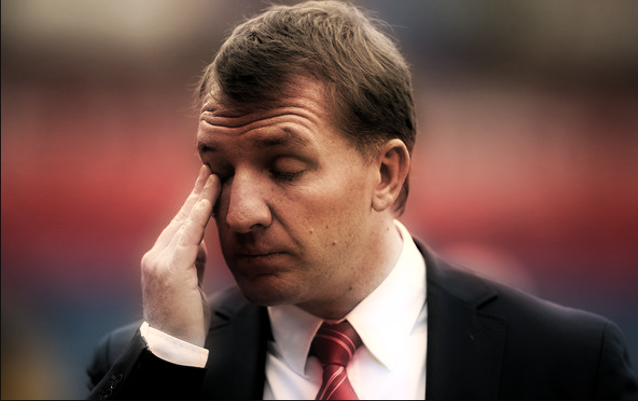 Brendan Rodgers' role has been called into question on many occasions since the 2013-14 near miss. In the modern game, surviving on the goodwill generated by one good season is not guaranteed, but the intransigence of FSG and a general sense of fairness allowed him to shepherd Gerrard into the minor leagues, cosset Sterling towards his big move and spend a year wondering how he went from the best strike force in recent league memory to being reluctant to field anyone up front. As the season meandered away from the cusp of Champions League qualification and turned to shit, even my support for Brendan- conceptually, as a coach that could create solid numbers from his squad- started to waver, and had he left in May, it would have been difficult to build a cogent case to retain him. The decline and defeat at Stoke was that bad, up there with the defeat that Rodgers himself supervised that ended Villas-Boas' tenure at Tottenham, that it seemed likely that he had to go. But the owners retained him, and they also backed him with another array of potentially useful signings and allowed the dice to tumble freely from their organisational hands, hoping once again, to land the big score. That the early weeks have been uninspiring has been entirely predictable to us seasoned Brendan watchers- his teams never start well- so that the fan base has seemingly decided in a large way to turn on him, although understandable, appears a little short sighted. Only Arsenal are finding a way to convert their goal bound shots less frequently that Liverpool, and that 19th place ranking is ably accompanied by a 17th place rank for all shots. With concern that too many efforts are flying from the boot of a mid-pitch positioned Coutinho, the return of Sturridge's nose for goal was a huge fillip this last weekend, but realistically, these conversion rates will improve. As will the dismal 59% save percentage. That gives us underwhelming figures at both ends of the conversion numbers. Worry not fans, there is a ton of leeway in a PDO of under 80 and if it doesn't kill the coach, he can ride the wave as it reemerges into something more normal. The vital numbers look fine: "shots for" levels are enough to rank top six so far and the only bad "shots against" game was when they shut-out Arsenal, who as we learned earlier shoot frequently against nearly everyone. Defense may be winning the day, for now, and the base for future success is reasonably solid. The 47 shots against Carlisle was an extreme example, and in the way it has been used as a stick to beat him with is reminiscent of Moyes' 81 crosses against Fulham. In itself it represented an erroneous focus on shooting for shooting's sake but a team's real problems arise when the shots dry up, and that simply hasn't happened. It would simply make no sense to remove Rodgers at this point having restructured the coaching department and given him half a new team. Last May was fine, or even June- rebuild from that point- and if after reaching twelve or fifteen games, Liverpool are firmly mid-table, then maybe there is some logic in sacking him. Until then, the smart thing for Liverpool to do is hold fire, see how the team progresses and make decisions when they have a solid process behind them rather than as a reactionary sop to the more skittish elements of the fan base. For if the process is faulty, the buck eventually stops with the decision makers that FSG have empowered, not the coach. ___________________ Thanks for reading! Follow me on Twitter @jair1970
Brendan Rodgers' role has been called into question on many occasions since the 2013-14 near miss. In the modern game, surviving on the goodwill generated by one good season is not guaranteed, but the intransigence of FSG and a general sense of fairness allowed him to shepherd Gerrard into the minor leagues, cosset Sterling towards his big move and spend a year wondering how he went from the best strike force in recent league memory to being reluctant to field anyone up front. As the season meandered away from the cusp of Champions League qualification and turned to shit, even my support for Brendan- conceptually, as a coach that could create solid numbers from his squad- started to waver, and had he left in May, it would have been difficult to build a cogent case to retain him. The decline and defeat at Stoke was that bad, up there with the defeat that Rodgers himself supervised that ended Villas-Boas' tenure at Tottenham, that it seemed likely that he had to go. But the owners retained him, and they also backed him with another array of potentially useful signings and allowed the dice to tumble freely from their organisational hands, hoping once again, to land the big score. That the early weeks have been uninspiring has been entirely predictable to us seasoned Brendan watchers- his teams never start well- so that the fan base has seemingly decided in a large way to turn on him, although understandable, appears a little short sighted. Only Arsenal are finding a way to convert their goal bound shots less frequently that Liverpool, and that 19th place ranking is ably accompanied by a 17th place rank for all shots. With concern that too many efforts are flying from the boot of a mid-pitch positioned Coutinho, the return of Sturridge's nose for goal was a huge fillip this last weekend, but realistically, these conversion rates will improve. As will the dismal 59% save percentage. That gives us underwhelming figures at both ends of the conversion numbers. Worry not fans, there is a ton of leeway in a PDO of under 80 and if it doesn't kill the coach, he can ride the wave as it reemerges into something more normal. The vital numbers look fine: "shots for" levels are enough to rank top six so far and the only bad "shots against" game was when they shut-out Arsenal, who as we learned earlier shoot frequently against nearly everyone. Defense may be winning the day, for now, and the base for future success is reasonably solid. The 47 shots against Carlisle was an extreme example, and in the way it has been used as a stick to beat him with is reminiscent of Moyes' 81 crosses against Fulham. In itself it represented an erroneous focus on shooting for shooting's sake but a team's real problems arise when the shots dry up, and that simply hasn't happened. It would simply make no sense to remove Rodgers at this point having restructured the coaching department and given him half a new team. Last May was fine, or even June- rebuild from that point- and if after reaching twelve or fifteen games, Liverpool are firmly mid-table, then maybe there is some logic in sacking him. Until then, the smart thing for Liverpool to do is hold fire, see how the team progresses and make decisions when they have a solid process behind them rather than as a reactionary sop to the more skittish elements of the fan base. For if the process is faulty, the buck eventually stops with the decision makers that FSG have empowered, not the coach. ___________________ Thanks for reading! Follow me on Twitter @jair1970
Elephants In The Room: West Ham, Leicester and Man Utd
 We've rapidly reached the six game mark in the 2015-16 Premier League season and slowly but surely some storylines are taking shape. Of course, if you are a regular reader of the content here on Stats Bomb you will be well aware of the duality of league storylines. Some exist on the surface powered by results and the table and are hammered repeatedly by the wider media. Others, and largely the ones we are interested in, bubble lightly beneath the surface, visible to those who look a little closer for a sharper perspective. These are fundamental truths and there is no secret surrounding them, so let's delve in amongst the murk and see what we can pull out. The Elephant In The Room 1: Leicester Leicester are having a great time. Unbeaten in six games, goals aplenty and one of the league's early stars in Riyad Mahrez. How good would it be if he could pull a Bale or Suarez and carry his team to previously unimagined heights? To pitch hard for a European slot, to maintain the run and bring overdue footballing glories back to the East Midlands? They are clawing back and overturning deficits like a latter year Ferguson team and clearly have a ton of energy and pace but there are aspects of their numbers that are shining like a beacon and suggest that their coin isn't going to keep coming down heads. They rank second in the league for all shot conversion (16%) and second in the league for goals per shot on target (45%); when league averages are 9.5% and 28%, we can see these numbers are clearly in orbit. On the flip side, they are ranking fourth in the "against" side of these metrics, which shows that they have struggled to control the opposition, hence the deficits, and hence the obvious conclusion that if you turn your games into basketball style Ossie Ardiles-managed shoot-outs, eventually the coin will start to land on tails. There has been a little debate recently around measuring of team talent, and over how long can you measure a team before you can be confident of their true quality. With football a game of limited fixtures in comparison to the more metric attuned North American sports, i'm firmly of the opinion that sample sizes limit the efficiency of rating teams in the short term, and linked to this, we can see that Leicester's positive run throughout the majority of 2015 has been powered in part by high conversion rates. Specifically over the last 19 games of last season they posted a 40% goals to shots on target rate and 12% all shot conversion. In that period their defence was posting par numbers, and their safety was secured. But it suggests that even 25 games can disguise a team's quality, unless you choose to believe that Leicester are of the class to challenge for Europe, and if we find the league table disguising the truth over this length of games, it's far from a stretch to understand that whole seasons can pass with similar results. But, in Leicester's favour: so far this season their shot numbers are pretty solid, and certainly nowhere near a level that should see them struggle long term. Mercifully, Claudio Ranieri is far too grizzled to fall for any hype around his team and was quoted last week playing down expectations: “We want to achieve the 40 points- to maintain [our position in the] Premier League is our goal. That is important for us" Quite. The Elephant In The Room 2: West Ham West Ham are having a great time. Four wins in six games, goals aplenty and one of the league's early stars in Dimitri Payet. How good would it be if he could pull a Bale or Suarez and carry his team to previously unimagined heights? To pitch hard for a European slot, to maintain the run and bring overdue footballing glories back to East London? In their current favour they sit third and lead the league alongside Leicester for goals scored with thirteen. They have also picked up three extremely hard to predict away wins and have ridden happily through a tough schedule. However, where we can suggest that parts of Leicester's form are positive and potentially sustainable, like their shot rates, West Ham's underlying numbers provide a delightful early storyline that points in only one direction: massive potential reversion. So extreme is their skew that it can be approached from multiple angles. The wider analytics community is already on this. Steve McCarthy's expected goals model places West Ham 18th, Paul Riley's subtly different expected goals model also places them 18th. Objectivefooty has picked this up too:
We've rapidly reached the six game mark in the 2015-16 Premier League season and slowly but surely some storylines are taking shape. Of course, if you are a regular reader of the content here on Stats Bomb you will be well aware of the duality of league storylines. Some exist on the surface powered by results and the table and are hammered repeatedly by the wider media. Others, and largely the ones we are interested in, bubble lightly beneath the surface, visible to those who look a little closer for a sharper perspective. These are fundamental truths and there is no secret surrounding them, so let's delve in amongst the murk and see what we can pull out. The Elephant In The Room 1: Leicester Leicester are having a great time. Unbeaten in six games, goals aplenty and one of the league's early stars in Riyad Mahrez. How good would it be if he could pull a Bale or Suarez and carry his team to previously unimagined heights? To pitch hard for a European slot, to maintain the run and bring overdue footballing glories back to the East Midlands? They are clawing back and overturning deficits like a latter year Ferguson team and clearly have a ton of energy and pace but there are aspects of their numbers that are shining like a beacon and suggest that their coin isn't going to keep coming down heads. They rank second in the league for all shot conversion (16%) and second in the league for goals per shot on target (45%); when league averages are 9.5% and 28%, we can see these numbers are clearly in orbit. On the flip side, they are ranking fourth in the "against" side of these metrics, which shows that they have struggled to control the opposition, hence the deficits, and hence the obvious conclusion that if you turn your games into basketball style Ossie Ardiles-managed shoot-outs, eventually the coin will start to land on tails. There has been a little debate recently around measuring of team talent, and over how long can you measure a team before you can be confident of their true quality. With football a game of limited fixtures in comparison to the more metric attuned North American sports, i'm firmly of the opinion that sample sizes limit the efficiency of rating teams in the short term, and linked to this, we can see that Leicester's positive run throughout the majority of 2015 has been powered in part by high conversion rates. Specifically over the last 19 games of last season they posted a 40% goals to shots on target rate and 12% all shot conversion. In that period their defence was posting par numbers, and their safety was secured. But it suggests that even 25 games can disguise a team's quality, unless you choose to believe that Leicester are of the class to challenge for Europe, and if we find the league table disguising the truth over this length of games, it's far from a stretch to understand that whole seasons can pass with similar results. But, in Leicester's favour: so far this season their shot numbers are pretty solid, and certainly nowhere near a level that should see them struggle long term. Mercifully, Claudio Ranieri is far too grizzled to fall for any hype around his team and was quoted last week playing down expectations: “We want to achieve the 40 points- to maintain [our position in the] Premier League is our goal. That is important for us" Quite. The Elephant In The Room 2: West Ham West Ham are having a great time. Four wins in six games, goals aplenty and one of the league's early stars in Dimitri Payet. How good would it be if he could pull a Bale or Suarez and carry his team to previously unimagined heights? To pitch hard for a European slot, to maintain the run and bring overdue footballing glories back to East London? In their current favour they sit third and lead the league alongside Leicester for goals scored with thirteen. They have also picked up three extremely hard to predict away wins and have ridden happily through a tough schedule. However, where we can suggest that parts of Leicester's form are positive and potentially sustainable, like their shot rates, West Ham's underlying numbers provide a delightful early storyline that points in only one direction: massive potential reversion. So extreme is their skew that it can be approached from multiple angles. The wider analytics community is already on this. Steve McCarthy's expected goals model places West Ham 18th, Paul Riley's subtly different expected goals model also places them 18th. Objectivefooty has picked this up too:
West Ham's form really is sustainable: - 40.7% SoTR + PDO of 137.2 = 65% of Goals & 12 points. Kinda reminds me of Lambert. — ObjectiveFootball (@ObjectiveFooty) September 20, 2015
Humble old counting shot metrics place them down towards the bottom: 18th and 17th in shots For and Against, 13th and 15th in the on target equivalents. So how on earth are they doing so well? The thirteen goals are a product of a mere twenty-two shots on target- 59%, which give or take is double the league average and a full 14% ahead of Leicester, who as we discovered moments ago are running extremely hot. West Ham are transcending heat with a rate this high. But there are aspects of their games that have contributed to this strange efficiency: "What like?" "In their last three games, all of which they won, West Ham have taken the lead inside ten minutes and in these games and the victory against Arsenal they have added to the score to make it 2-0." "Okay, that seems unlikely, but not entirely remarkable..." "How about this then? In their four wins, West Ham have scored with their first shot on target." "Right... that's interesting and sounds like a kind of thing that won't repeat." "For sure, it won't, it isn't a skill. And you know what else? In each of those games, they also scored with their second shot on target." "Wow, Bilic for Prime Minister, right? I mean there may be a vacancy..." What we find then is West Ham have spent more time this season at 2-0 than any other scoreline. They have spent 299 minutes leading, a full 76 minutes more than anyone else. With such regular and solid leads, it is arguable that they have been shelling for long periods of time, but this positive skew hasn't stopped at their rate of scoring, the opposition are taking a ton of shots but only converting them at 7%, and the overall save percentage is a high 78%. It's flowing right for West Ham at both ends. The problem being that these metrics have been shown not to sustain. West Ham's underlying metrics have powered a freak run, will definitely decline and this is likely to be as good as it gets for them. The Elephant in the Room 3: Man Utd It was widely reported that Man Utd had converted their last six shots on target having scored three from three against both Liverpool and Southampton, but also over the course of their last three games against Southampton, they have scored five from five too (2,0,3). Southampton haven't made a save from a Utd shot since late 2013-14, which is ludicrous. Man Utd's three goals from ten shots also spoiled my mini stat that none of last season's top seven had been converting their shots at a significantly above average rate, normally a necessary benchmark for a title challenger. Man Utd now stand at ~13%, Man City ~10%, Chelsea ~9%, Southampton ~7%, Liverpool and Tottenham around the 4 to 5% mark with Arsenal having almost entirely forgotten how to score. In contrast Utd are the only one of these teams outside the top seven for shots created. Once more, Louis van Gaal's extreme hallmarks of efficient shooting, opposition restriction and possession football seem to be borne out in the early numbers, and it remains to be seen if seemingly getting the rub is a function of his methods, or there's more going on there. However, his style is consistent and much like last season has so far been working effectively in the age old metric of "points gathering". For now Southampton continue to project like a solid team; only Man City have conceded fewer shots on target (11) than their 13, it's just eight of them have been converted. I would have few fears that they will eventually stabilise and perform similarly to last season. Obligatory Tottenham Narrow Victory If we ignore the goalkeeping heroics of Hugo Lloris and the helping hand of the woodwork, on the numbers, this looked like another solid performance from Tottenham and certainly not one they deserved to take anything less than three points from. Last season's first choice central midfield of Mason and Bentaleb was absent and a central midfield of Eric Dier and Dele Alli was far more effective than you might think. Dier now looks a first pick starter which is some transformation from centre back, and Alli has impressed when picked with his energy, confidence and unflappability. Throw in the relentless energy of Son, Lamela back in favour and the dearly needed return of Eriksen, if only from the bench and suddenly Tottenham look a team with options and reliable players. Early numbers like them too. Currently out-shooting the opposition by an average of five shots per game, a high save percentage (79%) is countered by a similarly self-limiting conversion rate (5%, SoT conversion 15%). Tit for tat there, but future successes may well be reliant on these metrics moving in parallel, something that could well be tested by next week's visit of Man City. __________________ Thanks for reading Follow me on Twitter @jair1970
What The Hell, Chelsea? Premier League Stat Round Up
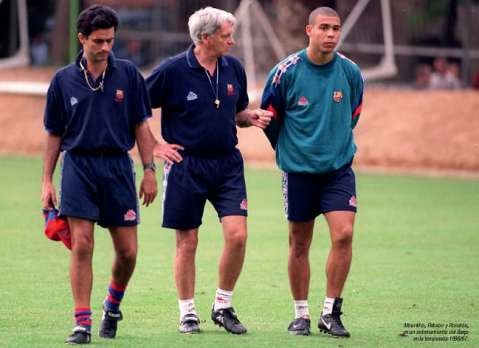
Porous Chelsea And Other Premier League Stat Stories: Week Three
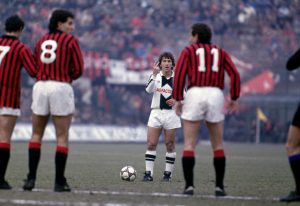 We reach week three in the
We reach week three in the EPL BPL top flight and once more I will add a necessary rider to the week's column insofar as ideas posited are firmly in the realm of suggestions and observations based on a very small sample of games rather than firm conclusions derived from sufficient inputs. Scything through the data and proclaiming that Riyad Mahrez is the second coming is something that can wait for a wider look at his true level. He's currently three non-penalty goals from 12 shots, 25% and hot, compared to four from 63 last season, 6% and cold. Chelsea's inability to prevent shots Back on 18th October 2014, Frazier Campbell netted a stoppage time consolation to prevent Chelsea achieving a clean sheet in an otherwise routine 2-1 victory. That goal was only the 24th shot on target Chelsea had conceded in the 2014-15 season, an excellent three per game, and they sat atop the league with seven wins and a draw from eight games. Jose had a glint in his eye, as we can see here: 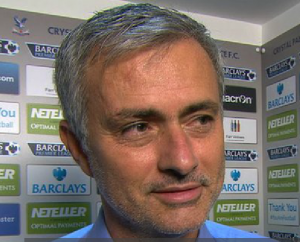
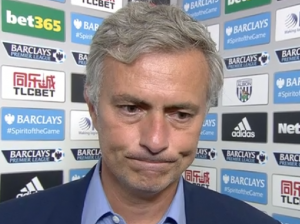
![]()
It's Only One Game... Premier League Review
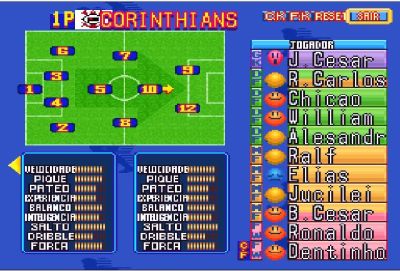 New Season, New Data As I fire up my spreadsheet, And stare at the shot count, A story line falls away, Here: a different truth, It's too soon for all the answers, Much more will transpire, Empty rows await their fill, Engorged they will inform James Yorke (Aged 37, nearly 38) First game bullshit A lot has been said about the results and performances in this first weekend of fixtures and a hell of a lot of it has been utter nonsense. Having seen a summer of football from the far flung regions of the world, or at least mainly the Americas, the return of the big European Leagues is welcomed with an ever increasing fanfare combined with a cavalcade of previews and opinions, some high quality, whilst others appear to have been plucked from the sky- mainly the "Man City will fail" brigade. As the transfer window grumbles on in the background we see unfinished squads take the field and quelle surprise, a strange result or two. These results, that would be disregarded if they sat on the tail of a mid season winning streak, take on entirely overstated positions and will likely have little bearing on the wider picture as we move forward. Arsenal losing to Villa in 2013-14 then winning 8 from 9 is often wheeled out, Man City lost to Cardiff the same year in week two and also to Stoke in week three last year. It can happen and with the season now starting in mid summer and the new fad of resting players thought exhausted by summer tournaments, August and the matches prior to the first and unwelcome international break are a slightly bizarre precursor to the season bedding down.
New Season, New Data As I fire up my spreadsheet, And stare at the shot count, A story line falls away, Here: a different truth, It's too soon for all the answers, Much more will transpire, Empty rows await their fill, Engorged they will inform James Yorke (Aged 37, nearly 38) First game bullshit A lot has been said about the results and performances in this first weekend of fixtures and a hell of a lot of it has been utter nonsense. Having seen a summer of football from the far flung regions of the world, or at least mainly the Americas, the return of the big European Leagues is welcomed with an ever increasing fanfare combined with a cavalcade of previews and opinions, some high quality, whilst others appear to have been plucked from the sky- mainly the "Man City will fail" brigade. As the transfer window grumbles on in the background we see unfinished squads take the field and quelle surprise, a strange result or two. These results, that would be disregarded if they sat on the tail of a mid season winning streak, take on entirely overstated positions and will likely have little bearing on the wider picture as we move forward. Arsenal losing to Villa in 2013-14 then winning 8 from 9 is often wheeled out, Man City lost to Cardiff the same year in week two and also to Stoke in week three last year. It can happen and with the season now starting in mid summer and the new fad of resting players thought exhausted by summer tournaments, August and the matches prior to the first and unwelcome international break are a slightly bizarre precursor to the season bedding down.  Man Utd v Tottenham I've noted repeatedly that Pochettino and van Gaal favour a prescriptive and strict formulation for their football and after yet another "tactical battle" in which each team cancelled out the other, we should probably be glad that every team doesn't play in this fashion, regardless of any success that is derived from it. But what do I mean? Since van Gaal's arrival in the league, he has now faced Tottenham and Pochettino three times and on each occasion we have seen a minimal exchange of shots and little to thrill. Utd's win at Old Trafford last year at least offered three goals, but also killed the contest quickly and if we look at the shot counts from the three games and consider the average Premier League match contained a shade under 26 shots last year, we can see that when the immovable object encounters his twin, the results aren't pretty:
Man Utd v Tottenham I've noted repeatedly that Pochettino and van Gaal favour a prescriptive and strict formulation for their football and after yet another "tactical battle" in which each team cancelled out the other, we should probably be glad that every team doesn't play in this fashion, regardless of any success that is derived from it. But what do I mean? Since van Gaal's arrival in the league, he has now faced Tottenham and Pochettino three times and on each occasion we have seen a minimal exchange of shots and little to thrill. Utd's win at Old Trafford last year at least offered three goals, but also killed the contest quickly and if we look at the shot counts from the three games and consider the average Premier League match contained a shade under 26 shots last year, we can see that when the immovable object encounters his twin, the results aren't pretty: 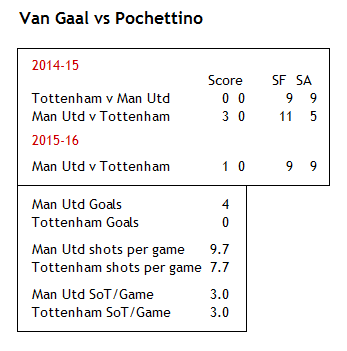 Dull stuff, huh? 18, 16 and 18 shots in total. Particularly underwhelming from the Spurs end of things too with zero goals. So: what's interesting to me here is we have a quick opposition to an early take. Tottenham's defence shaped up quite well against Man Utd yesterday and a perfunctory analysis might presume that Eric Dier in central midfield is a winning idea or that Alderweireld is the answer to Spurs' defensive woes. These things may in time show to be true, but we can see that in the games against Man Utd last year, the rate of shot prevention was similarly effective. Even the 0-3 could be explained away somewhat if we recall Fellaini sprinting clear to finish- a rarity, or Carrick's annual goal and the fact that three goals were scored from three shots on target. In fact, we come full circle if we want to take anything from the game, Van Gaal and Pochettino have teams that play prescriptive and restrictive football, they played it last year and they're already playing it this. Is more of the same enough for Man Utd to challenge and Tottenham to go for the top four? It looks a stretch to me. What have we learnt? Maybe less than is generally thought, after all it's one game. Stoke (v Liverpool) It's possible I should be careful what I say here given the kerfuffle some analysis of this game has already caused but again, it looked to me that despite time passing and players being purchased, the intrinsic personalities of the two teams remain from last season too. In other words, Stoke are better than most people generally think and Liverpool are a work in progress. Here we found another game in which the two teams cancelled each other out; an extremely understandable scenario given Rodgers' need to avoid defeat and with the 1-6 defeat remaining fresh in the memory. Stoke were a pretty solid team last year and their defence was a strong point. They ranked 6th in Goals Against, 7th in Total Shot Ratio and 9th in Shot on Target Ratio. Indeed, if they could just get something going on the front end they have a strong base to build on. They struggled with their rate of getting shots on target last year in a big way (ranked 20/20) and that's something that can be reasonably presumed to improve. With the interesting signing of players that were perhaps expected to make it at bigger clubs like van Ginkel and Afellay pitching up alongside the hopefully returning, similarly statused Bojan and maybe even The Xherdan Shaq Attack, we have a level of talent and diversity many worlds away from the arse end of a Rory Delap throw in. I think they are the club most likely to "do a Southampton" and grasp onto the coattails of the contenders and Hughes has done a solid job of improving them and changing their style. And maybe the talent level has stepped up a notch? I am also in rarified company: Robbie Savage has predicted a 7th place finish for Stoke. That he blotted his copybook with a 5th slot for Man City shall be overlooked here. Oh by the way, Arsenal had 22 shots to West Ham's eight. Shit happens. _____________________________ Thanks for reading Follow me on Twitter here: @jair1970 This column will appear every week after a set of fixtures throughout the season, so make sure you come back and also take a look at our season previews, a diverse and talented collection of writers contributed fine work and they are really worth your time.
Dull stuff, huh? 18, 16 and 18 shots in total. Particularly underwhelming from the Spurs end of things too with zero goals. So: what's interesting to me here is we have a quick opposition to an early take. Tottenham's defence shaped up quite well against Man Utd yesterday and a perfunctory analysis might presume that Eric Dier in central midfield is a winning idea or that Alderweireld is the answer to Spurs' defensive woes. These things may in time show to be true, but we can see that in the games against Man Utd last year, the rate of shot prevention was similarly effective. Even the 0-3 could be explained away somewhat if we recall Fellaini sprinting clear to finish- a rarity, or Carrick's annual goal and the fact that three goals were scored from three shots on target. In fact, we come full circle if we want to take anything from the game, Van Gaal and Pochettino have teams that play prescriptive and restrictive football, they played it last year and they're already playing it this. Is more of the same enough for Man Utd to challenge and Tottenham to go for the top four? It looks a stretch to me. What have we learnt? Maybe less than is generally thought, after all it's one game. Stoke (v Liverpool) It's possible I should be careful what I say here given the kerfuffle some analysis of this game has already caused but again, it looked to me that despite time passing and players being purchased, the intrinsic personalities of the two teams remain from last season too. In other words, Stoke are better than most people generally think and Liverpool are a work in progress. Here we found another game in which the two teams cancelled each other out; an extremely understandable scenario given Rodgers' need to avoid defeat and with the 1-6 defeat remaining fresh in the memory. Stoke were a pretty solid team last year and their defence was a strong point. They ranked 6th in Goals Against, 7th in Total Shot Ratio and 9th in Shot on Target Ratio. Indeed, if they could just get something going on the front end they have a strong base to build on. They struggled with their rate of getting shots on target last year in a big way (ranked 20/20) and that's something that can be reasonably presumed to improve. With the interesting signing of players that were perhaps expected to make it at bigger clubs like van Ginkel and Afellay pitching up alongside the hopefully returning, similarly statused Bojan and maybe even The Xherdan Shaq Attack, we have a level of talent and diversity many worlds away from the arse end of a Rory Delap throw in. I think they are the club most likely to "do a Southampton" and grasp onto the coattails of the contenders and Hughes has done a solid job of improving them and changing their style. And maybe the talent level has stepped up a notch? I am also in rarified company: Robbie Savage has predicted a 7th place finish for Stoke. That he blotted his copybook with a 5th slot for Man City shall be overlooked here. Oh by the way, Arsenal had 22 shots to West Ham's eight. Shit happens. _____________________________ Thanks for reading Follow me on Twitter here: @jair1970 This column will appear every week after a set of fixtures throughout the season, so make sure you come back and also take a look at our season previews, a diverse and talented collection of writers contributed fine work and they are really worth your time.
Footedness And Why Erik Lamela Is Worth £30m
Why Erik Lamela is worth £30m
When young players break through and score a ton of goals it's easy to take a look at their goal to shot rates and be cynical.
In fact, unless you are Ronaldo, it's likely that any season of high goal volume will be accompanied by a tasty conversion rate. In the course of my pondering, I came to look at young players who had scored a good volume of goals: specifically players who at the age of 21 or under had finished a season with 15 or more non-penalty goals.
Looking at the Enlightened data Era (2009-10 onwards) this left me with a pretty tiny sample of qualifiers; Kane and Lukaku (twice!) in the Premier League, Drmic in the Bundesliga and El Shaarawy and Lamela in Serie A. I had a quick check back and Messi only qualified once, but by that point he was already unstoppable, so little to critique there...
Now each of these players converted their shots at a rate high above league averages of around 9-10%, as you might expect for forwards – between 14% and 23% (Drmic) and each converted their shots on target at a similarly high level- 33 to 43% compared to an average of ~30%.
The higher end of these rates are obvious warning signs: that a player has scored a volume of goals is inevitably impressive and inflates their perceived reputation, but largely, aspects of the method are likely unrepeatable.
Of the five, three have been sold for large transfer fees, Lamela for around £30m, Lukaku for a shade less and El Shaarawy was bought by Milan for 20 million Euros. Kane's value, at this moment, is out of the range of any club on the planet, particularly Man Utd.
Ahem.
So I got to thinking: both the higher fees here were paid for left footed players and that chimed with some research I put together some while back about foot prevalence in football. Taking a sharp turn, that's where we now head.
Foot dominance
Footedness is an area of investigation that appears to have been somewhat under-researched in the public domain.
There is an academic paper from September 2009 called The Returns to Scarce Talent: Footedness and Player Remuneration in European Soccer by Alex Bryson, Bernd Frick and Rob Simmons that attempted to find out the effect two-footedness had on wages. They concurred that indeed two-footed players commanded a greater wage premium and in the course of establishing this carried out valuable work.
Using data sourced from transfermarkt and a sample of over 2,200 players from five leagues, they showed that of outfield players:
...the majority (…) are right-footed (60%); 22% are left-footed players and only 18% of the players in the five leagues are equally strong with both feet. The classification of players is undertaken by external experts who assess players based on observation of matches.
Then: Carey et al., “Footedness in world soccer: an analysis of France ’98” (2001), a study that decided two-footedness was far less prevalent, around 1%, with decidedly stricter criteria. Interestingly here, the disappearing 17% landed entirely on the right footed side leading to a general 80:20 split. There is also this blog that discusses the two papers in a lighter manner.
The blog is labelled “Part 1” and sadly it appears part two never came to fruition. Each study and the less heavyweight comparison blog are worth your perusal. And as far as I can tell there is little else.
Research
I went about this a little differently given that I am not an academic team and am aware of the limitations of my source material- WhoScored to be precise- but many months ago I started collecting shot and goal information and the foot used therein about higher volume shooters in the top leagues. Initially I collected 100 players from the Premier League in 2013-14.
Then some interesting players figured in the next 20 slots so I collected them too. And then I repeated the task for preceding seasons and then for other major European Leagues. I had to create a cut-off point somewhere and there seemed a little logic here, being a shooting chart, 120 players would likely collect somewhere around the 5 to 8 highest volume shooters per team: the main contributors, mostly midfielders and forwards.
Call it a labour of love, call it a pain in the arse or whatever, I did it because I was interested to and I eventually ended up with 3000 player seasons to prod and poke at. Now anyone who has collected shot and goal data will tell you that that's only half the job: next you need to throw out penalties, as they skew results and do not offer a helpful representation of general play; they are an entirely separate skill. The vast majority of penalties were easy to strip out, as the taker showed a clear predominance in the data for one foot.
A very small element of this section was subject to my interpretation, it was an inevitable problem that needed to be solved. So penalties? Out they went. And then I had to pull away the headers and finally split the shots into two categories.
By this point it was getting pretty frosty down in hell, so I figured I should look a little at the data. This is a chart that shows the prevalence of right-footedness in those 3000 player seasons- note players will duplicate- amongst just shots taken with the foot (of course, left-footedness is just the opposite graph): 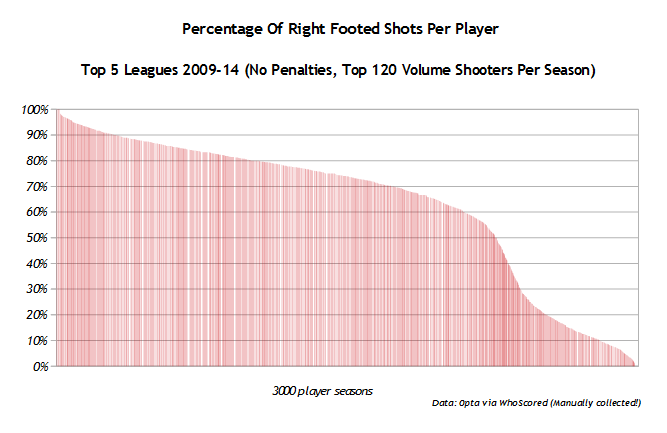
Ain't that a pretty curve? As a general rule the pattern holds for each league; a sample of four 2013-14 leagues can be seen here: 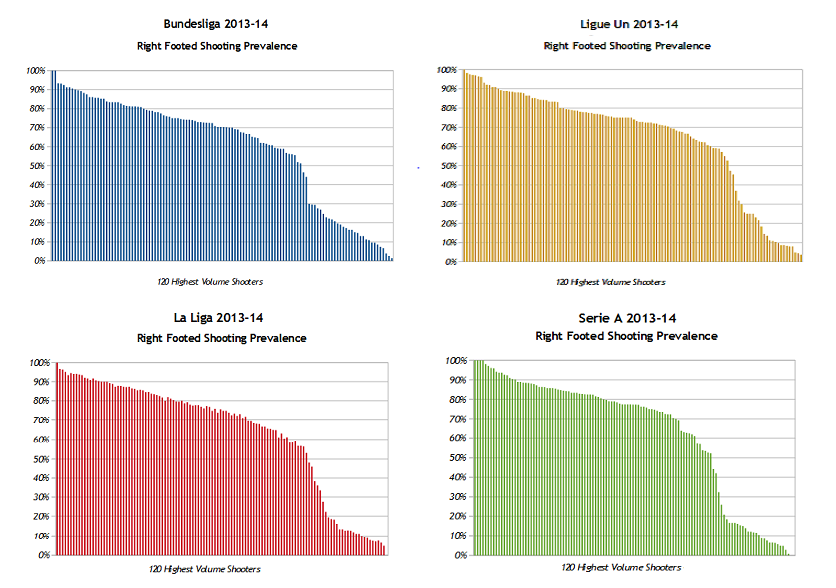
If we're looking for differences, the Bryson paper suggested that there were higher rates of two-footed and left footed players in the Bundesliga and there is a subtle difference in the shape of its graph here; the trend is very similar but the tail of left footers is noticably longer.
What these graphs show is that entirely as expected: the vast majority of players are right footed. However it is worth considering exactly how many. The earlier Bryson, Frick and Simmons paper presented their findings as follows: 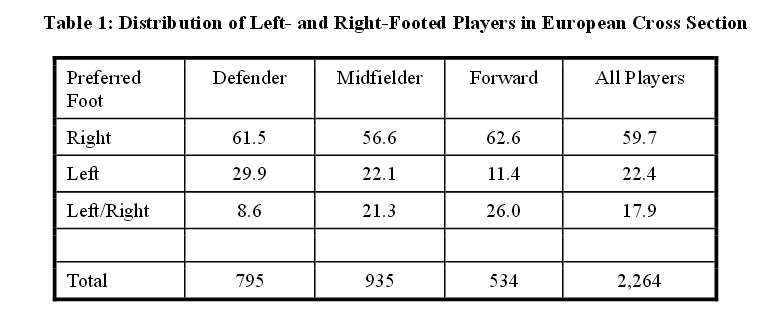
The main anomalies worth noting here are in defence; presumably the strict left/right definitions of positions here encourage a greater proportion of left footers than elsewhere in the team. Also the lack of left footers in forward positions, for which I have less tangible ideas.
For my own study I needed to find a rate of shots taken that would imply predominance. I theorised it could be defined as if a player uses their favoured foot for over two-thirds of their shots and then checked the rates for both 60% and 70% by way of comparison: 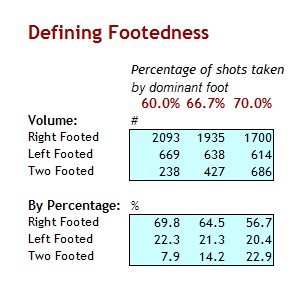
What is encouraging here is the definition of left footed players. In my sample it lands at a shade over 20% for each of the three suggested definitions, very similar to the overall sample observed by the Bryson survey.
With a predominance of attacking players in my sample, it could be theorised that a definition should be specified towards the higher end, but that remains to be seen. As a follow on to the coherence in the left footer definition we find a grey area between right footed and two footed, something which reflects back on the different definitions from the two earlier surveys.
Depending on where you peg the dominant percentage, the two groups fuel and supply each other. And we can see that 80:20 holds but more strongly as a definition between Right/Two-footed and Left footed.
Back to Lamela
The conclusion around Lamela or Lukaku is clear.
Their value is in their scarcity.
The Bryson study implies that a forward such as Lukaku is five to six times as uncommon as an equivalent right footed counterpart. Even being generous, you can locate and scout three right footed shooters for every Lamela you may find. And this shows the value in somebody as divisive as Andros Townsend.
Though confident to shoot with either foot, to be a left footer in an attacking role holds a significant potential premium. If there's anything to take from this it's surely to recognise that when a team is recruiting a left footed attacking player, they are shopping in a smaller market than for their opposite side.
Maybe even a set-up incorporating a wide right player (Navas?) and a right footer on the left side (Nasri/Sterling?) is less a tactical tweak rather than a function of necessity... Who knows? Anyway, I have other theories i've pondered or examined over months-left footers are more left footed than right footers are right footed is just one- but hopefully, this post will create a bit of interest in what I feel is an underdeveloped aspect of using the data.
There are possible implications for expected goals modelling too as people strive towards improving work here. And there are also factors around conversion rates that merit discussion but are beyond the remit of this initial post. I appreciate that people may look in and instantly see different (better?) methods of examining this subject but i've attempted to work to create an accessible point to start from and provoke thought. Cherish those lefties, for they are few.
Thanks for reading!
____________________________________________
Follow me on Twitter @jair1970
Why Did Yohan Cabaye End Up At Crystal Palace?
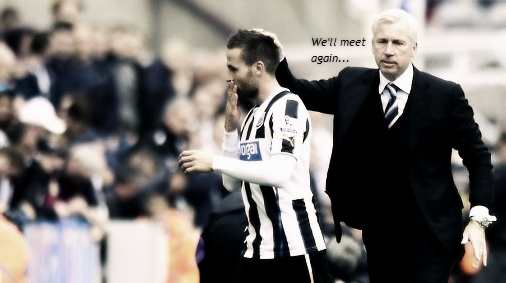 Would you like Yohan Cabaye on your team? This must have been a question that floated around a few boardrooms in early summer and it seems that fewer decision makers put a tick in the “Yes” box than you might have thought. The Premier League is awash with cash these days and a player that cost Paris Saint Germain around £20m just 18 months ago and was available about half that tariff failed to rouse the interest of the top four, or even the top seven. So why not? Cabaye at Newcastle Back in the January window of 2013-14, Cabaye left the Premier League after a storming half season that surely represented his best form. A comparative rarity in the league: a genuine two-way midfielder, capable of driving play forward and with a strong shot usually employed from range, he was also unafraid of putting in defensive work. In fact, in some research I did around that time, I could only find three other midfielders with his level of contribution, in regard defensive work married to attacking output: Ramsey- in his breakout season- and in a potentially intriguing hint for any Schweinsteiger deniers- the still contributing Lampard and Gerrard. At that time, he looked as though he could start in any Premier League midfield and enhance it. But the petrodollars landed and Mike Ashley cashed in and back to France he went. Whilst selling your best player at the absolute peak of his form seems like a stupid thing to do, and disregarding Newcastle's annual spring malaise, a bid of the scale received combined with a recognition that he'd hit the high watermark made it arguably a smart move. Newcastle are smart, right? Right? Hello? Anyway, at that precise moment, a high performing 27 year old midfielder was available. You could theorise he had two absolute peak years left and on the front end you were buying this output:
Would you like Yohan Cabaye on your team? This must have been a question that floated around a few boardrooms in early summer and it seems that fewer decision makers put a tick in the “Yes” box than you might have thought. The Premier League is awash with cash these days and a player that cost Paris Saint Germain around £20m just 18 months ago and was available about half that tariff failed to rouse the interest of the top four, or even the top seven. So why not? Cabaye at Newcastle Back in the January window of 2013-14, Cabaye left the Premier League after a storming half season that surely represented his best form. A comparative rarity in the league: a genuine two-way midfielder, capable of driving play forward and with a strong shot usually employed from range, he was also unafraid of putting in defensive work. In fact, in some research I did around that time, I could only find three other midfielders with his level of contribution, in regard defensive work married to attacking output: Ramsey- in his breakout season- and in a potentially intriguing hint for any Schweinsteiger deniers- the still contributing Lampard and Gerrard. At that time, he looked as though he could start in any Premier League midfield and enhance it. But the petrodollars landed and Mike Ashley cashed in and back to France he went. Whilst selling your best player at the absolute peak of his form seems like a stupid thing to do, and disregarding Newcastle's annual spring malaise, a bid of the scale received combined with a recognition that he'd hit the high watermark made it arguably a smart move. Newcastle are smart, right? Right? Hello? Anyway, at that precise moment, a high performing 27 year old midfielder was available. You could theorise he had two absolute peak years left and on the front end you were buying this output:  So, a cursory glance and we have a solid contributor who had the half season of his life. He and Tiote were the main volume passers in these Newcastle teams and both offered extensive defensive contribution. That last season, Cabaye, with slightly more license and an ability to roam took his shot and goal rate into the realm of a forward. But, and this is key, 75% of his shots were coming from range. Of the 16 non-penalty goals he scored in his time at Newcastle, ten of them were with his right foot and from outside the box. The four from 48 shots in 2013-14 was an extremely high rate, and was highly unlikely to sustain. The quality of performance seen- the kind that attracts a wealthy suitor's eye- was built from goals and shots. 18 months at PSG And so to Paris, the glitz, the glamour a multi-talented squad full of equivalent or better players and 18 months of well... nothing much? Let's add in the PSG numbers and a bit of information on minutes and team shot contribution:
So, a cursory glance and we have a solid contributor who had the half season of his life. He and Tiote were the main volume passers in these Newcastle teams and both offered extensive defensive contribution. That last season, Cabaye, with slightly more license and an ability to roam took his shot and goal rate into the realm of a forward. But, and this is key, 75% of his shots were coming from range. Of the 16 non-penalty goals he scored in his time at Newcastle, ten of them were with his right foot and from outside the box. The four from 48 shots in 2013-14 was an extremely high rate, and was highly unlikely to sustain. The quality of performance seen- the kind that attracts a wealthy suitor's eye- was built from goals and shots. 18 months at PSG And so to Paris, the glitz, the glamour a multi-talented squad full of equivalent or better players and 18 months of well... nothing much? Let's add in the PSG numbers and a bit of information on minutes and team shot contribution:  The first thing to note is Cabaye never nailed down a starting spot at PSG. That in itself is only mildly indicative given the huge depth of talent in their squad but he moved from being very much a big fish in a moderately sized pool to one of the shoal in a lake. Revered analytics sage Paul Riley hinted at this in a tweet: The problem with half decent players in bad teams is that they look like world beaters His role in the PSG team, when picked, was clearly different to before. Given a world class array of attacking talent in front of him, rather than say, Shola Ameobi, the expectation on him wasn't to drive forward and shoot, as he had at Newcastle but keep things ticking over. During his time at Newcastle, he averaged around 45 to 55 passes per 90 and lead the team in pass volume. At PSG, who were naturally dominant in their league in most metrics, this rocketed up to 75 to 85 passes per 90 but his attacking contribution fell in a hole. This seems like the motif of a player that has been confounded by two issues; team instructions and possibly his own inhibitions. Noting that his “key pass” rate halved during his sporadic PSG appearances will have done little to convince his coach or teammates of his importance. His shot rate returned to his pre-2013-14 Newcastle level; and understandably given his over-performance in long range conversion prior to his move, they stopped going in. There may well have been further issues causing problems here, but we've supposed enough for now. So, from being a first on a team-sheet key guy for Lille and then Newcastle, he became a bit part player for the French giants. He only completed 90 minutes three times in 2014-15 and got on the pitch for a mere 37% of available league minutes during his season and a half. Palace? Upon signing for Crystal Palace, plenty of people expressed surprise that a club of higher standing hadn't attempted to secure his services. There was a definite bias at work here: many people will have their most recent memory of Cabaye as rampaging through the Premier League, fewer will have visualised him warming a Parisian bench and there are rational explanations for the move that extend beyond the obvious. The straightforward re-coupling of Cabaye with Pardew is a simple hook to hang the transfer on. Pardew supervised the best form of his career, managed him for two and half seasons and will no doubt know how to incorporate him into the team he is fashioning at Palace. I'd imagine playing alongside a Tiote-like defensive midfielder in Jedinak would be the plan and once more, Cabaye returns to be the big fish in a smaller pond. This factor, combined with his age- his presumed peak years are behind him- look like the key reasons why a larger club hasn't taken a chance on him. With wages likely generous, and his reputation forged in France then cemented in England, other destinations were unlikely. Unfortunately, the time for Cabaye to join the top tier passed on PSG's bench. We can easily see why the top 7 of the Premier League may have passed on his transfer:
The first thing to note is Cabaye never nailed down a starting spot at PSG. That in itself is only mildly indicative given the huge depth of talent in their squad but he moved from being very much a big fish in a moderately sized pool to one of the shoal in a lake. Revered analytics sage Paul Riley hinted at this in a tweet: The problem with half decent players in bad teams is that they look like world beaters His role in the PSG team, when picked, was clearly different to before. Given a world class array of attacking talent in front of him, rather than say, Shola Ameobi, the expectation on him wasn't to drive forward and shoot, as he had at Newcastle but keep things ticking over. During his time at Newcastle, he averaged around 45 to 55 passes per 90 and lead the team in pass volume. At PSG, who were naturally dominant in their league in most metrics, this rocketed up to 75 to 85 passes per 90 but his attacking contribution fell in a hole. This seems like the motif of a player that has been confounded by two issues; team instructions and possibly his own inhibitions. Noting that his “key pass” rate halved during his sporadic PSG appearances will have done little to convince his coach or teammates of his importance. His shot rate returned to his pre-2013-14 Newcastle level; and understandably given his over-performance in long range conversion prior to his move, they stopped going in. There may well have been further issues causing problems here, but we've supposed enough for now. So, from being a first on a team-sheet key guy for Lille and then Newcastle, he became a bit part player for the French giants. He only completed 90 minutes three times in 2014-15 and got on the pitch for a mere 37% of available league minutes during his season and a half. Palace? Upon signing for Crystal Palace, plenty of people expressed surprise that a club of higher standing hadn't attempted to secure his services. There was a definite bias at work here: many people will have their most recent memory of Cabaye as rampaging through the Premier League, fewer will have visualised him warming a Parisian bench and there are rational explanations for the move that extend beyond the obvious. The straightforward re-coupling of Cabaye with Pardew is a simple hook to hang the transfer on. Pardew supervised the best form of his career, managed him for two and half seasons and will no doubt know how to incorporate him into the team he is fashioning at Palace. I'd imagine playing alongside a Tiote-like defensive midfielder in Jedinak would be the plan and once more, Cabaye returns to be the big fish in a smaller pond. This factor, combined with his age- his presumed peak years are behind him- look like the key reasons why a larger club hasn't taken a chance on him. With wages likely generous, and his reputation forged in France then cemented in England, other destinations were unlikely. Unfortunately, the time for Cabaye to join the top tier passed on PSG's bench. We can easily see why the top 7 of the Premier League may have passed on his transfer:
- Arsenal: recent policy involves world stars (Ozil, Sanchez) and fewer older players. Ramsey also occupies a similar role.
- Man Utd: the proposed Schweinsteiger signing shows the tier of player that they are looking at. There is a difference between winning French trophies and World and European titles.
- Chelsea/Man City: Odd Delph bid apart, generally shop at top table
- Liverpool/Tottenham: both buying policies revolve around younger players
- Southampton: again represent the opposite to Cabaye in transfer policy.
There simply weren't viable options for a sporadically involved 29 year old player beyond the mid-tier of the Premier League. In a sense he has returned to his natural level. It gives Palace a significant upgrade in their midfield, at least for a year or two, and is another representation of the increased spending power in the Premier League, moreso that they would meet his wage demands. Linked to that, of all the middle to lower tier, Palace seem most keen to spend to their limits. Good luck Yohan Cabaye. Maybe you will star once more in a side that is built to allow you to shine? _______________________________________ Thanks for reading! Follow me on Twitter: @jair1970 If you don’t already, be sure to follow the @Statsbomb account to ensure you are aware of all our new content
